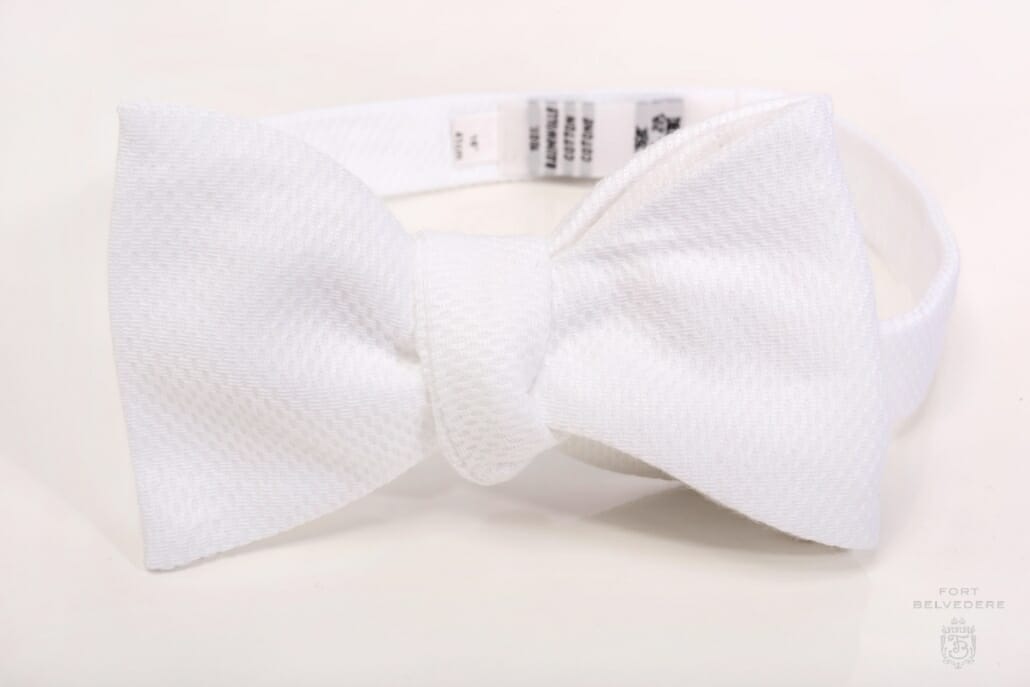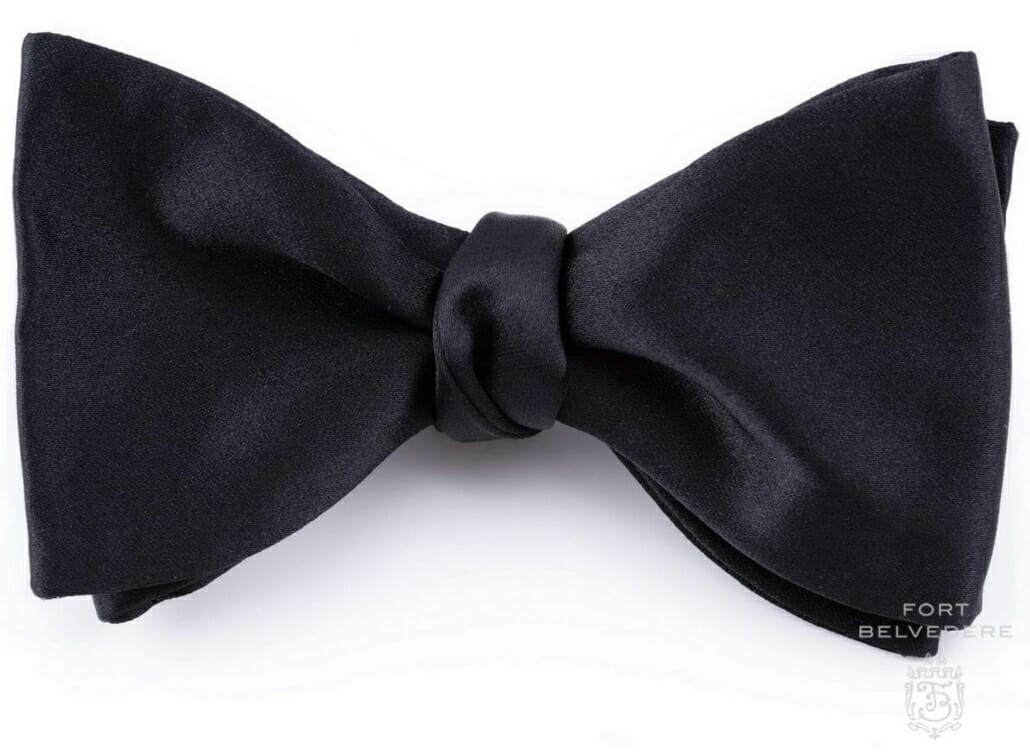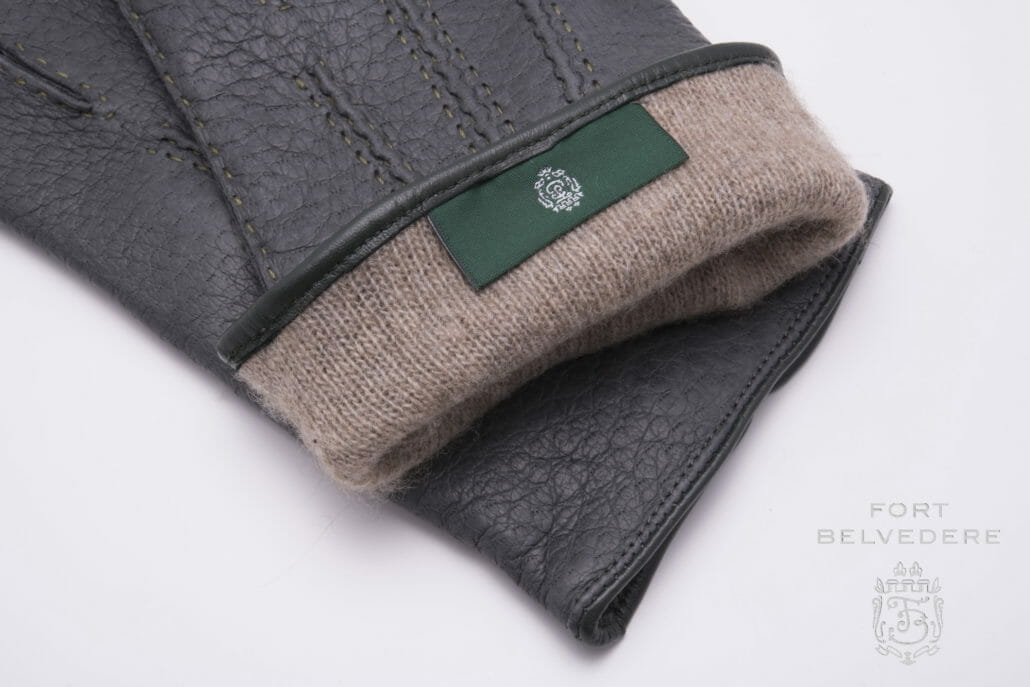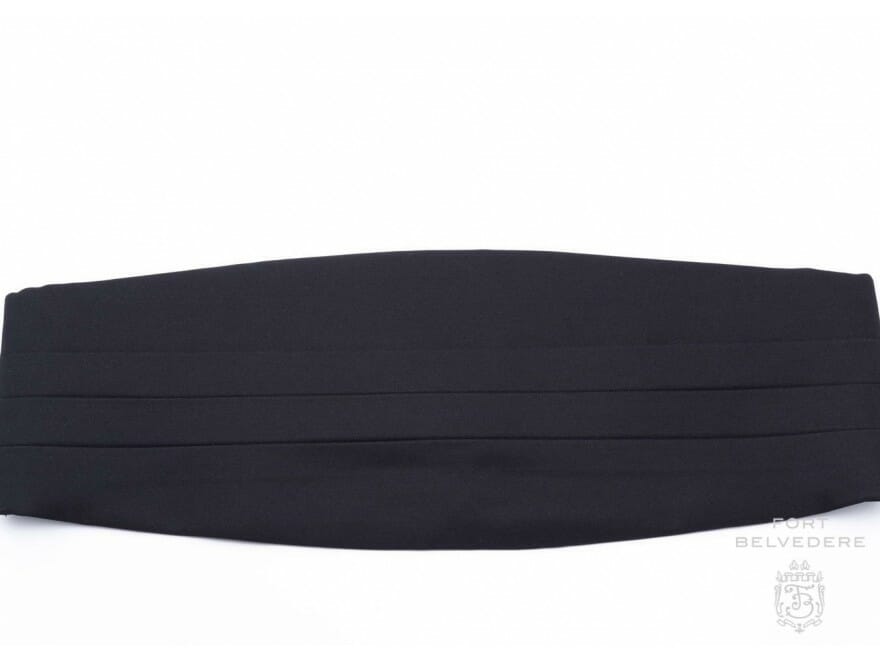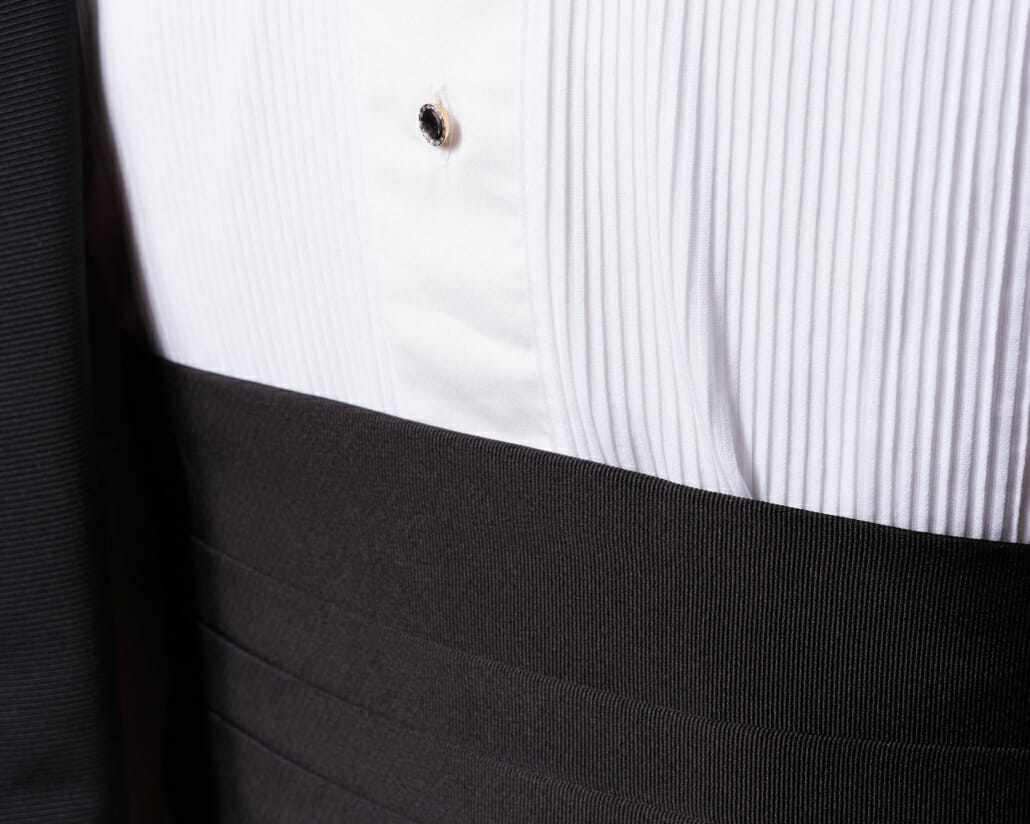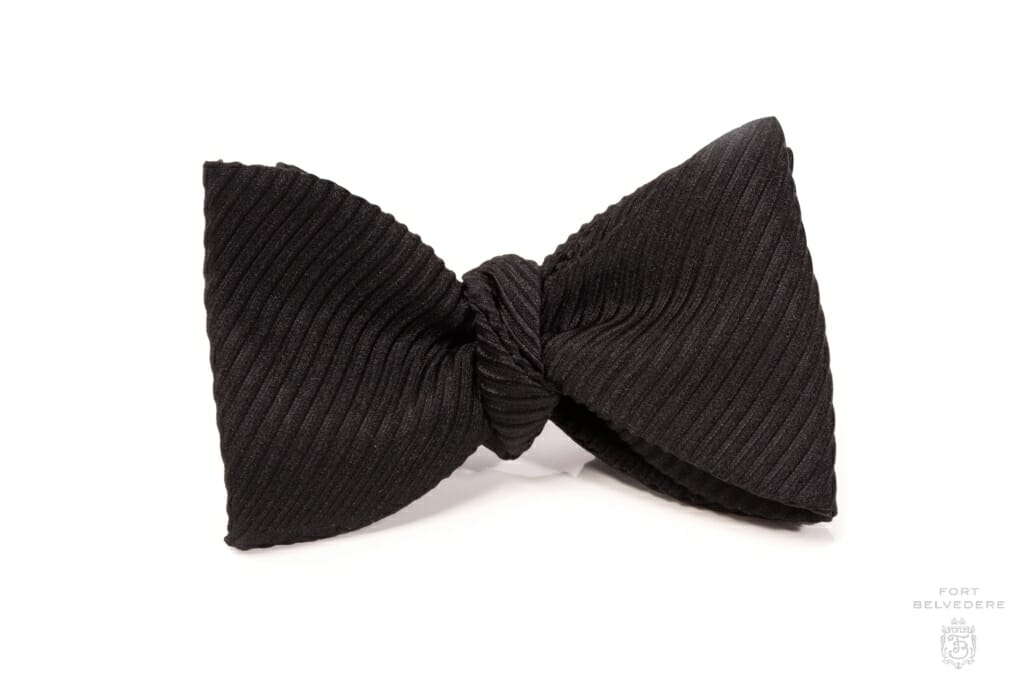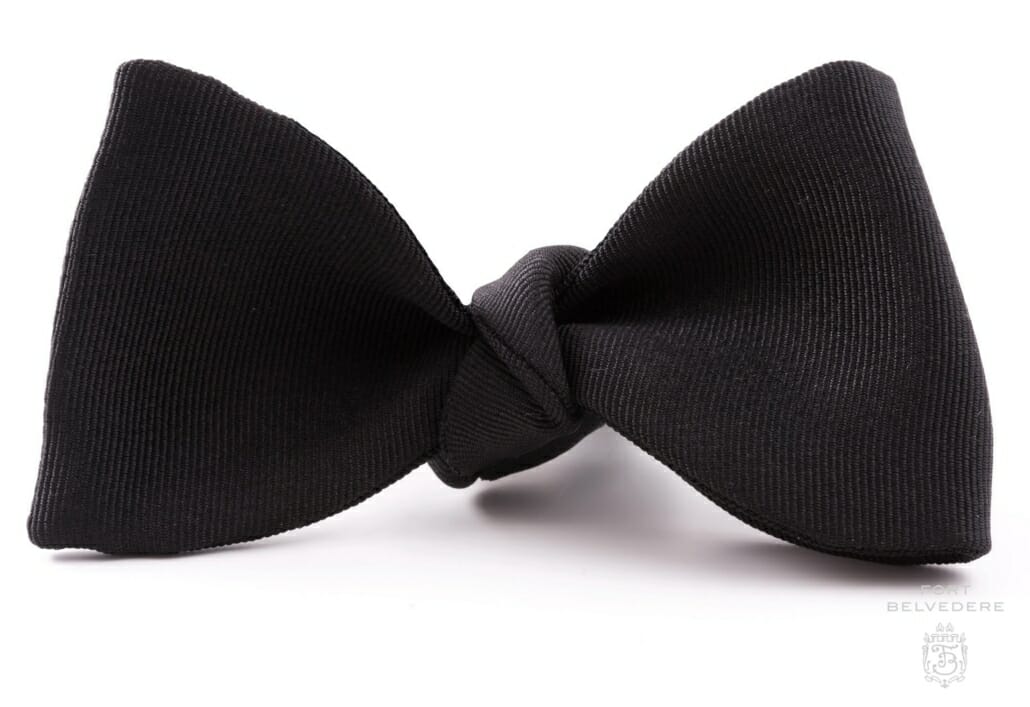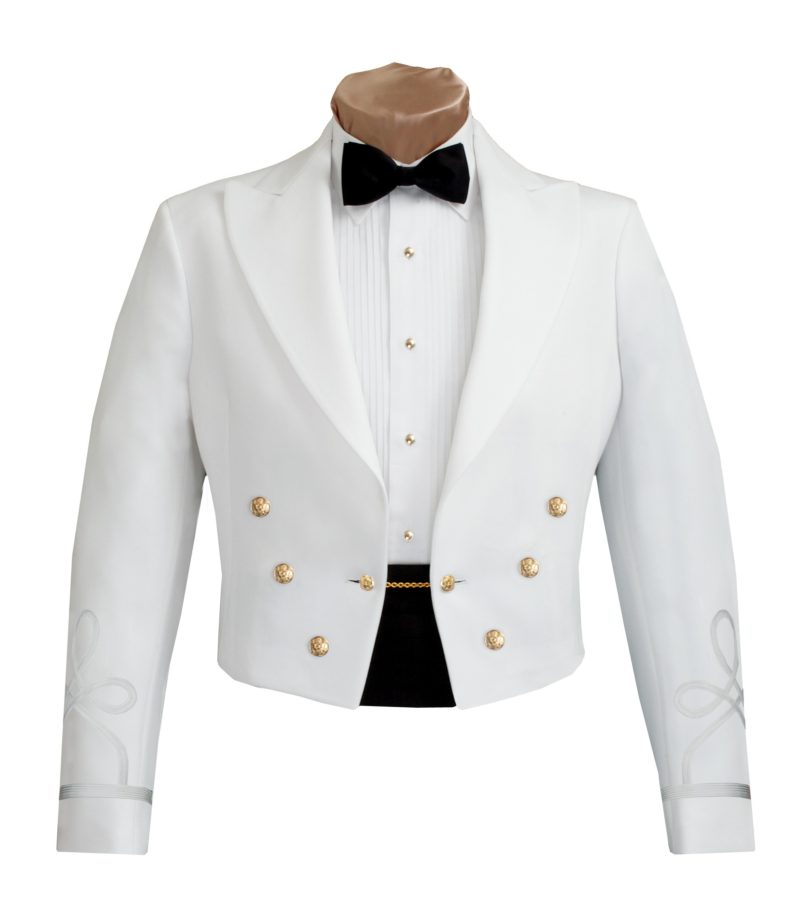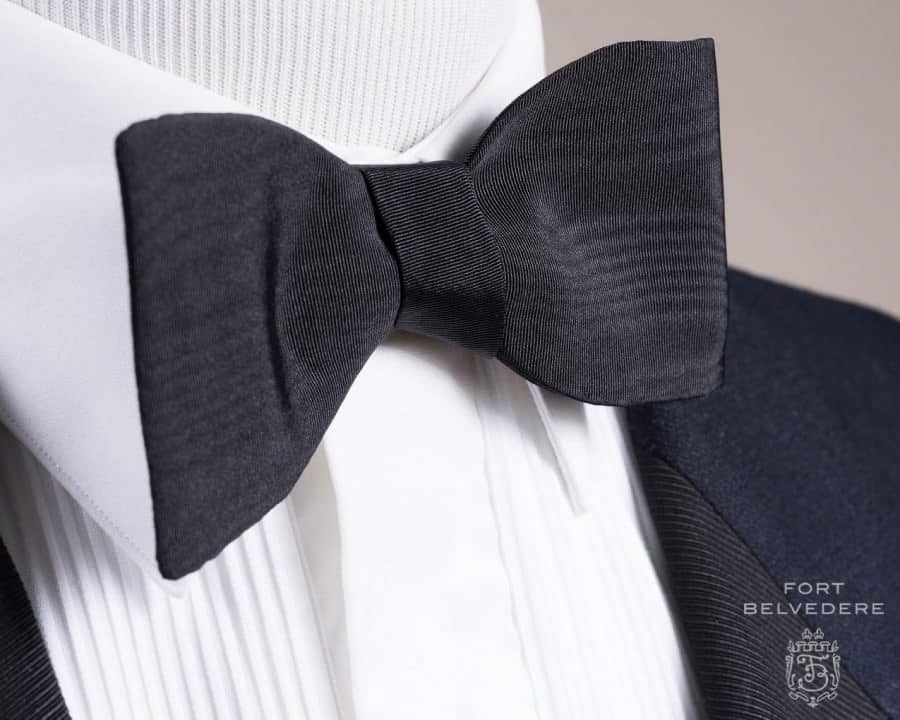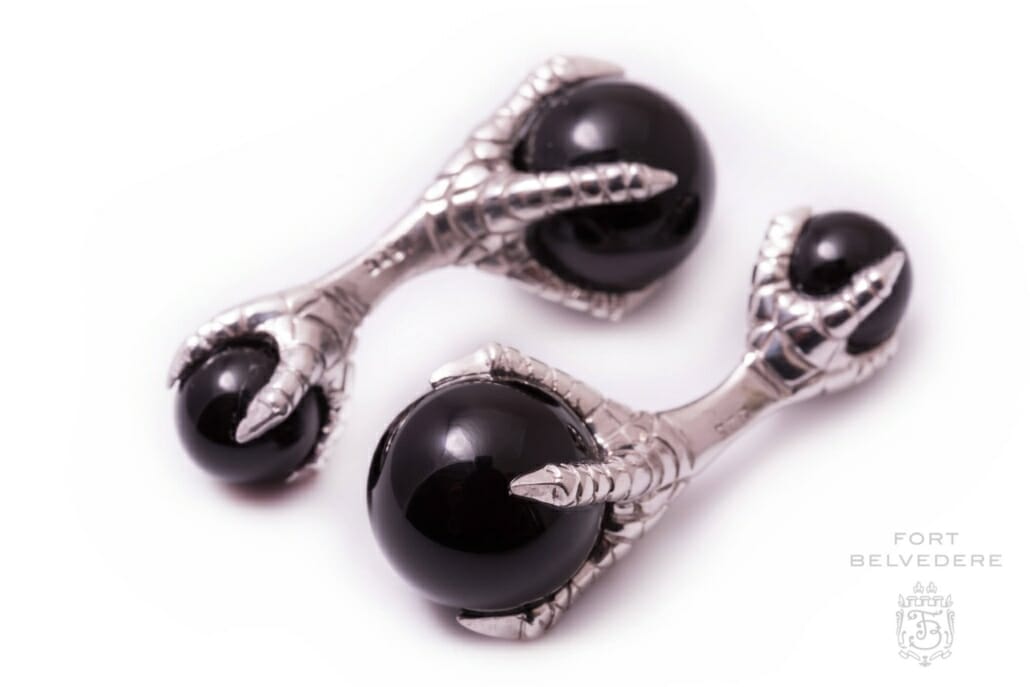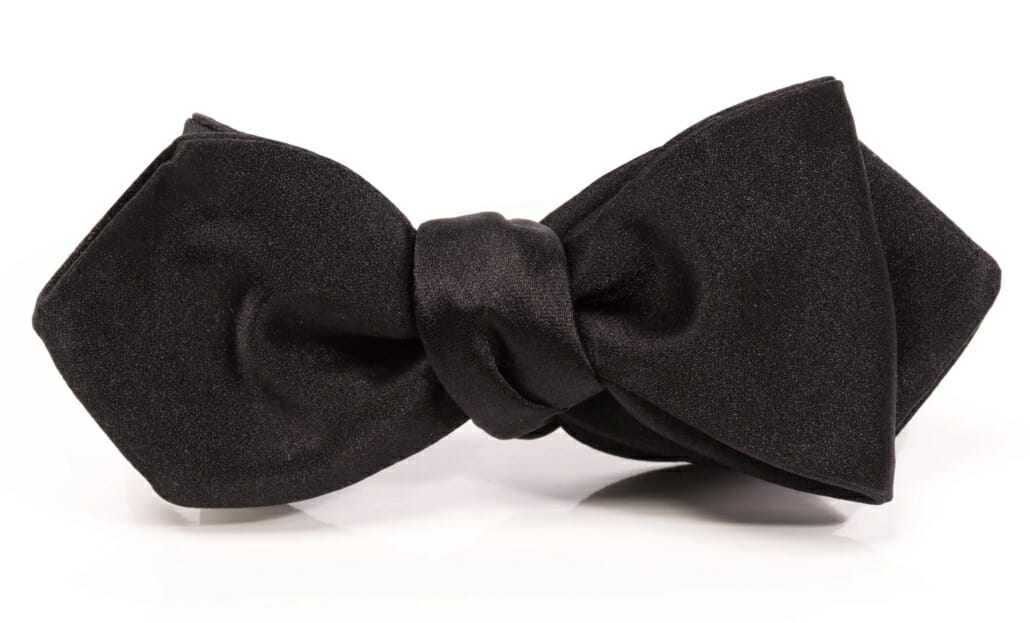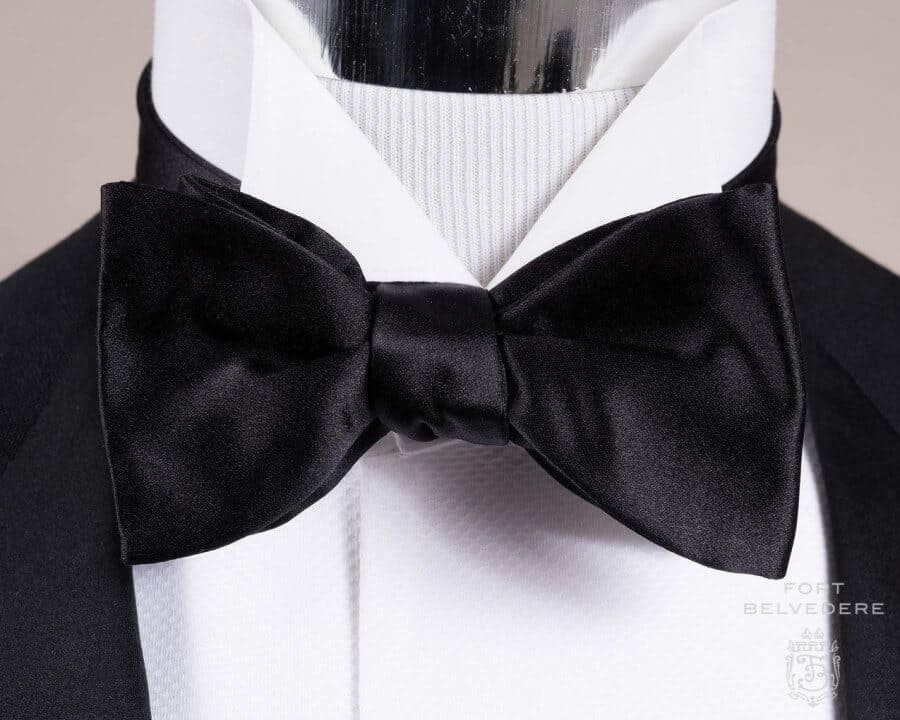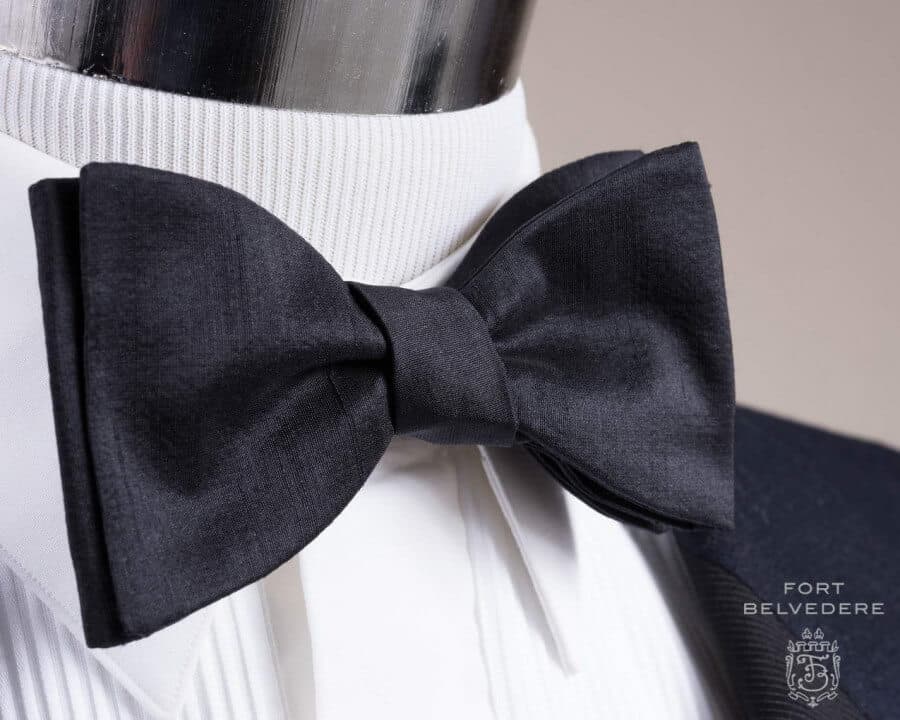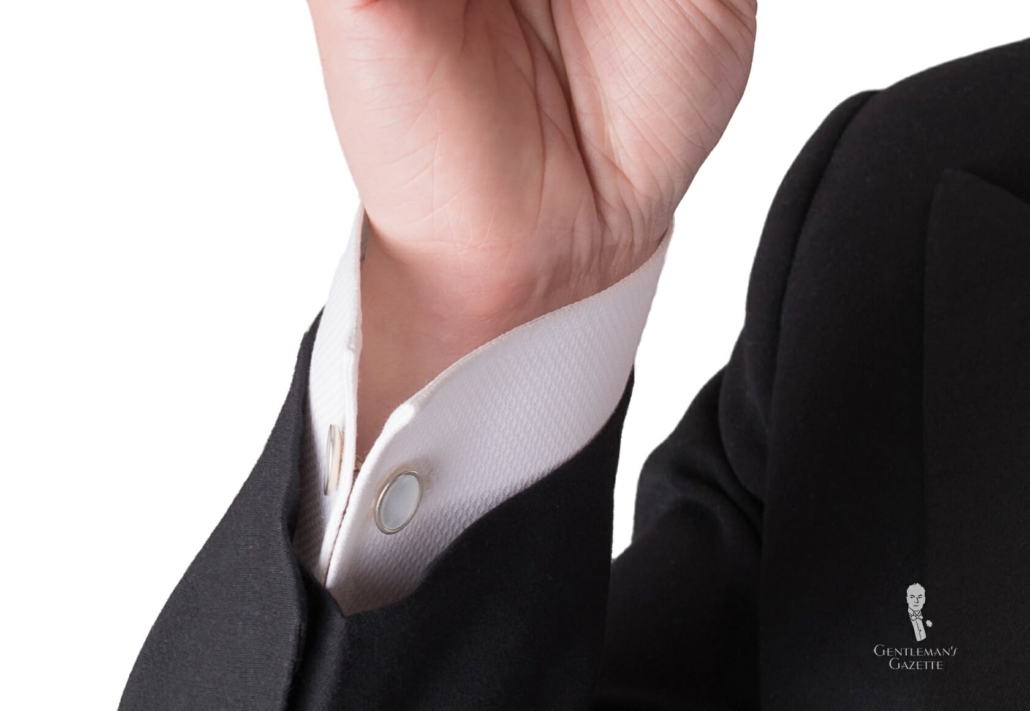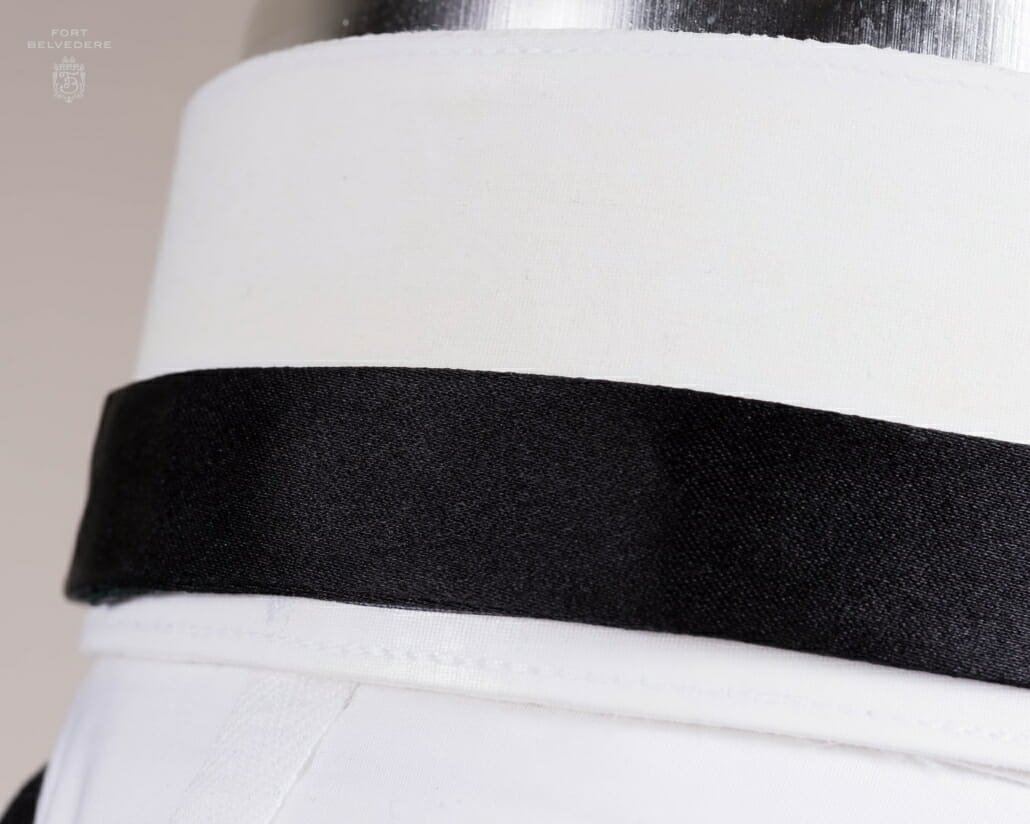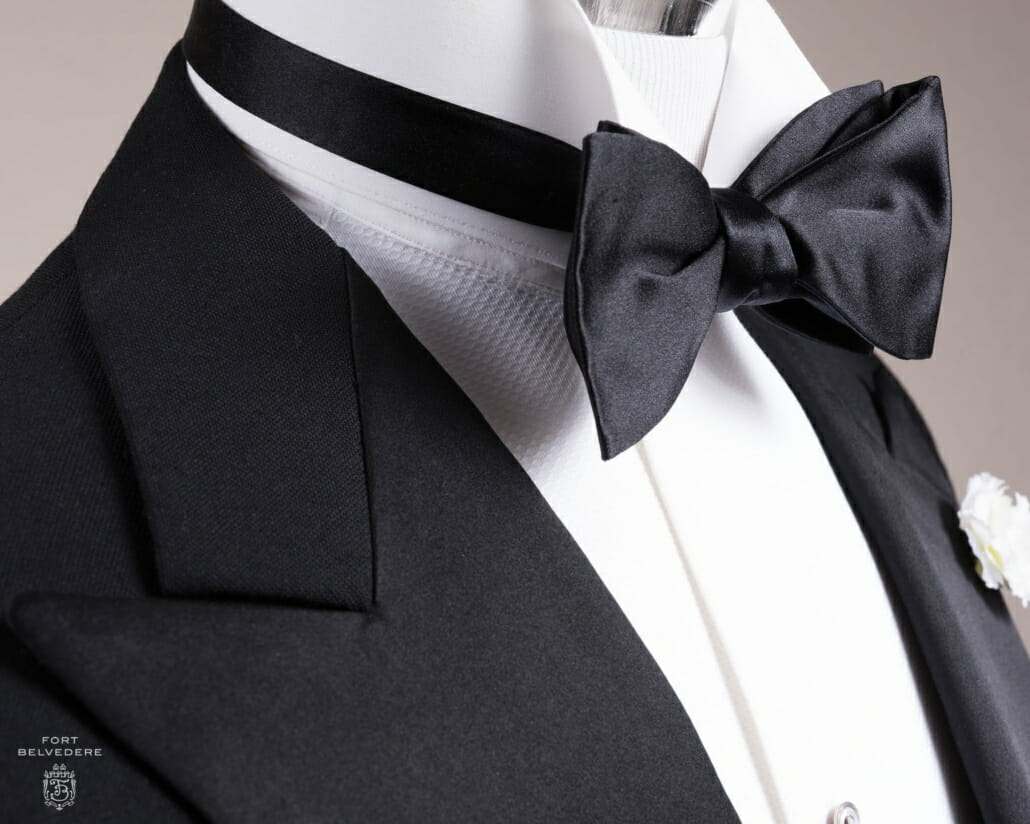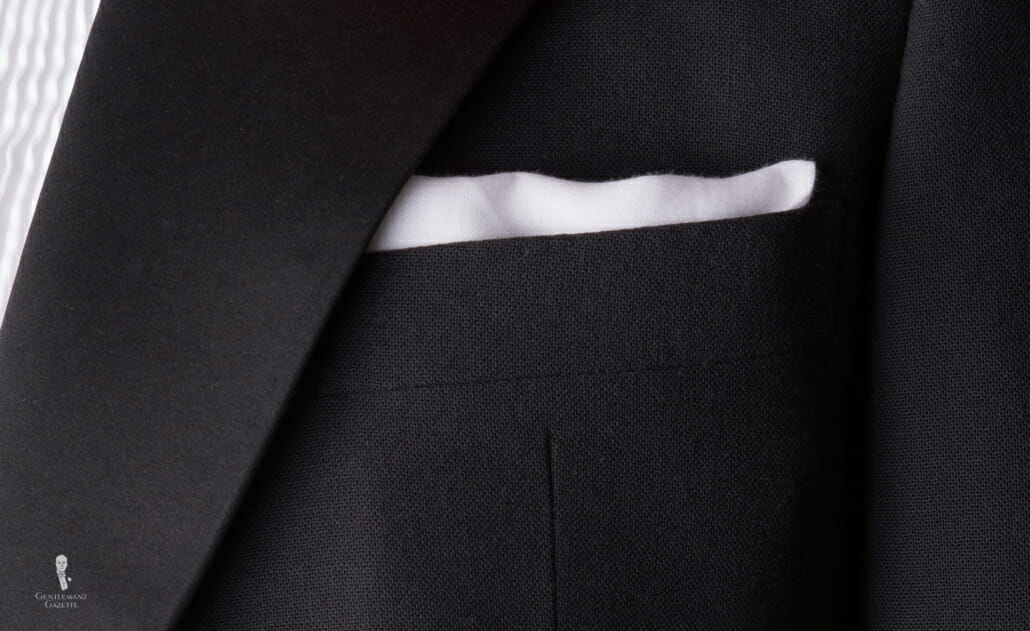Attached Collar
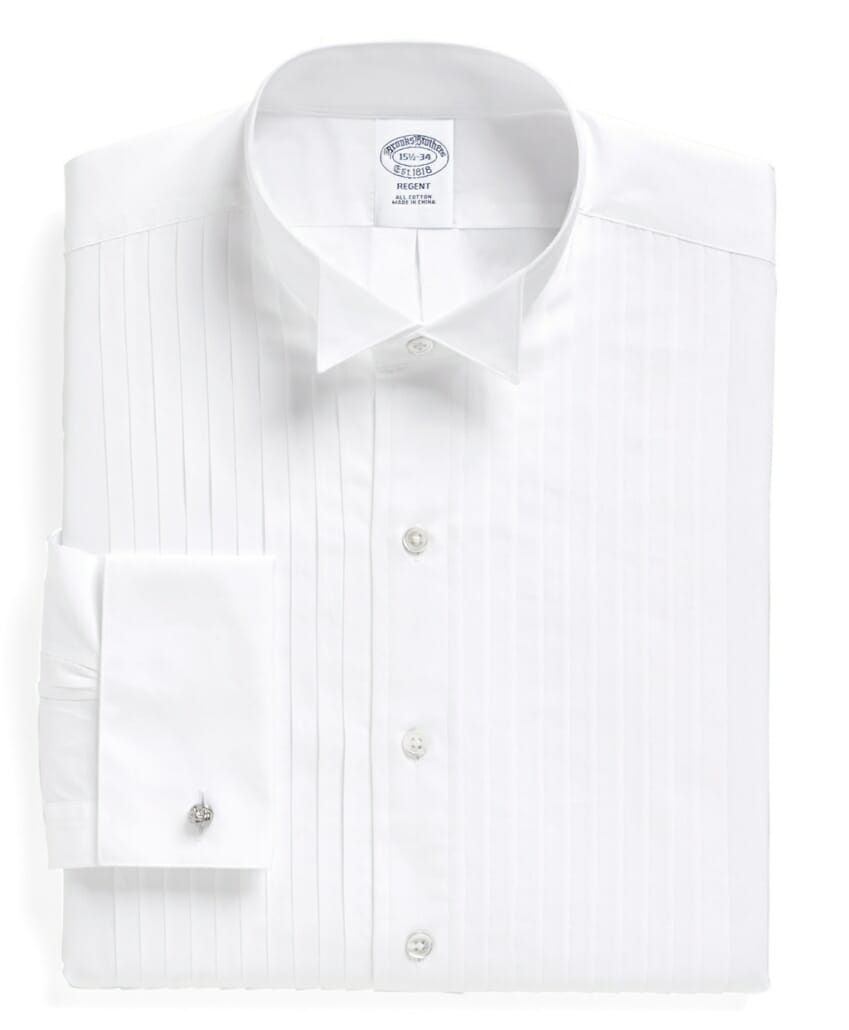
White attached wing collar shirt with pleated front
a shirt collar that is permanently attached to the shirt; can be turndown, wing or band collar; compare with detachable collar.
Band Collar
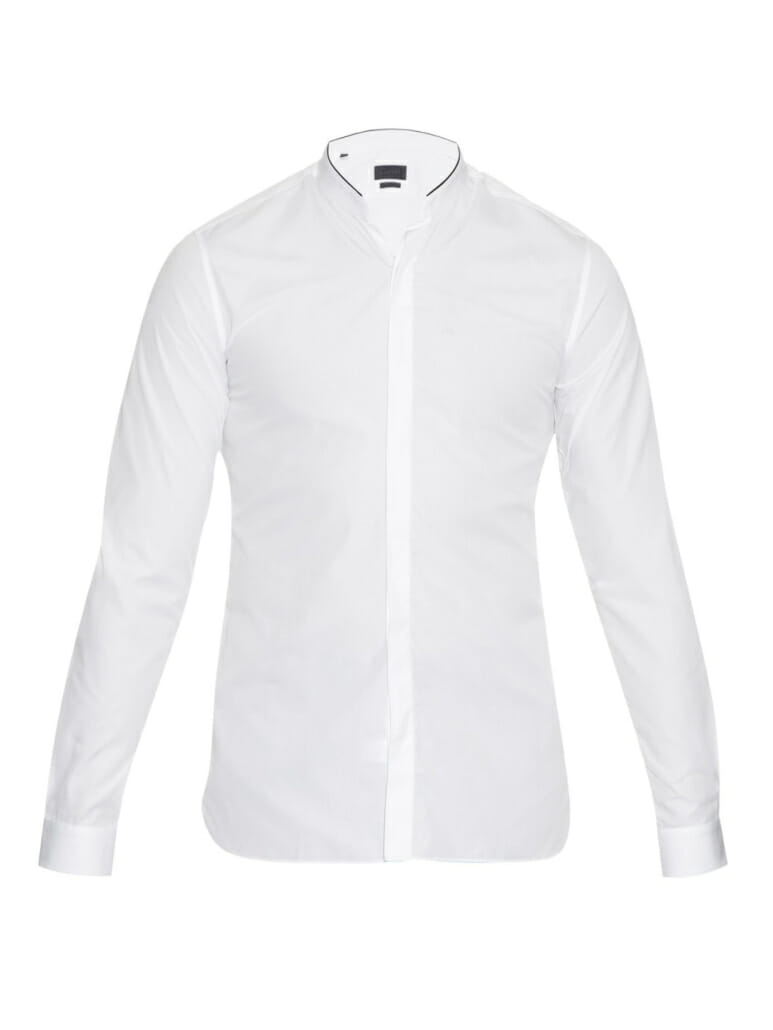
a fashion-forward shirt collar that stands upright and encircles the neck in a band; a popular formal shirt alternative in the 1990s usually with a decorative “button cover” over the top button; not proper black tie; compare with turndown collar and wing collar
Barathea
a fine textured worsted fabric that has a broken rib weave and a pebbly texture; used primarily in wool for evening clothes and silk for Neckwear and Cummerbunds but also for evening shoelaces. It is less shiny and more matte than satin; pronounced bare-e-THEE-a
Barrel Cuff
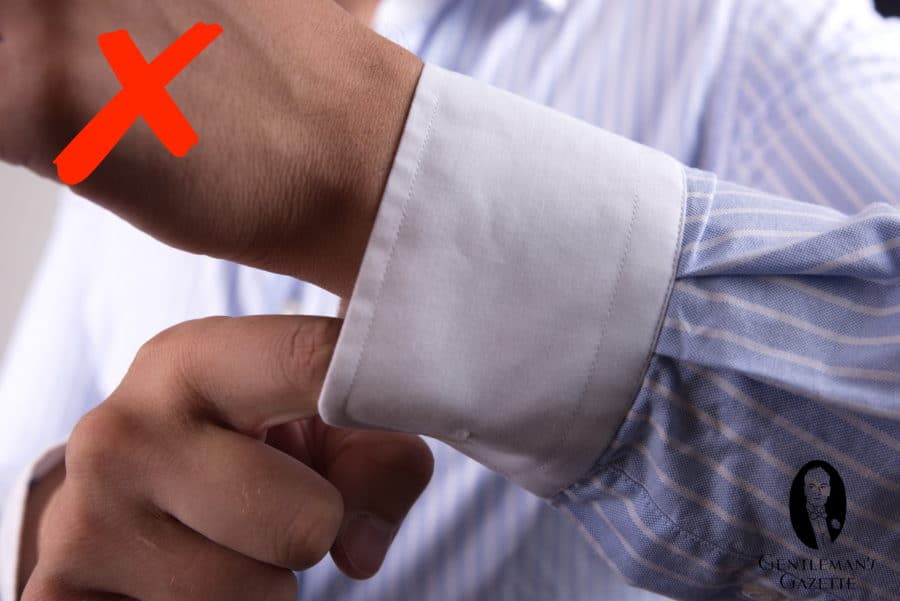
see “single cuff“
Batwing Bow Tie

a bow tie with cricket bat-shaped blades; wing ends can be straight or pointed; straight-end version also known as a “club bow” in America; compare to butterfly bow tie
Besom Pocket
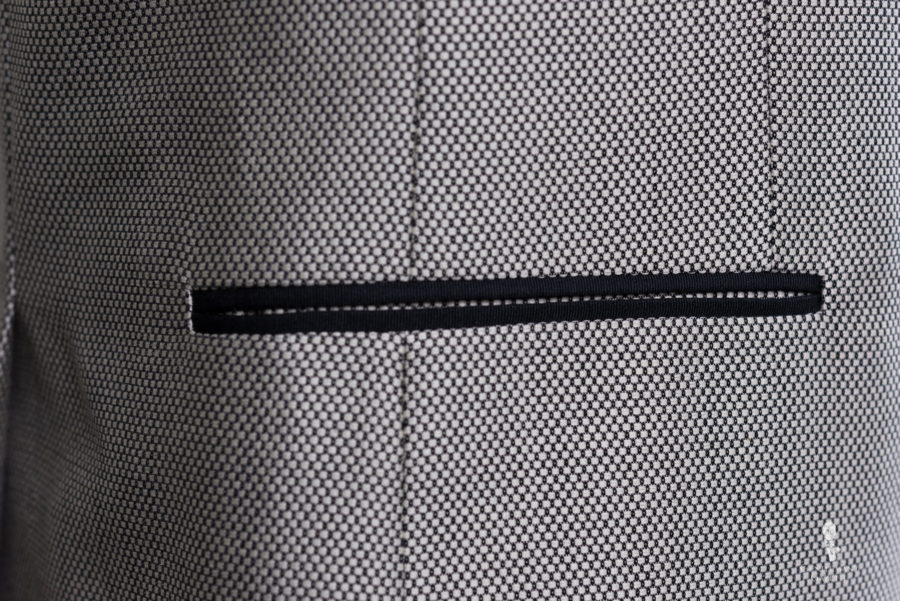
an inset pocket with a narrow welted edge above the opening; known as a double besom when there is also a welt below the opening; can either be jetted (as shown here) or have a flap; pronounced BEE-zem
Bib

see “bosom“
Bird’s Eye piqué
diamond pattern piqué
Black Tie

a dress code consisting of specifically defined attire
(note: written as “black-tie” when used as an adjective)
Body Coat
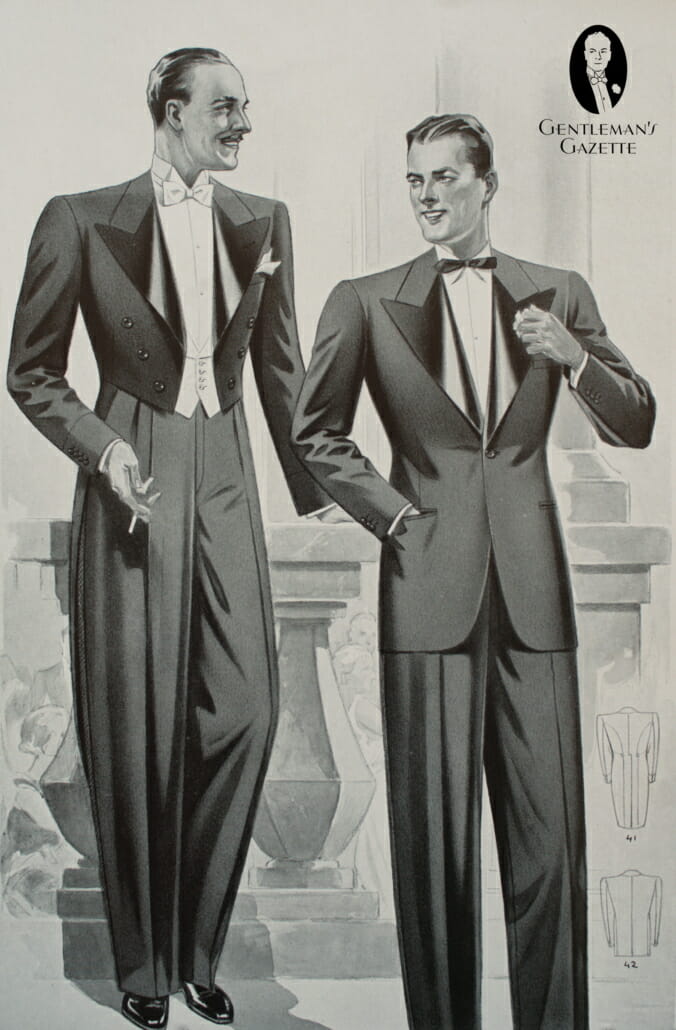
A coat cut very close to the body using vertical and horizontal seams. A morning coat, tailcoat or frock coat are body coats.
Boiled Shirt
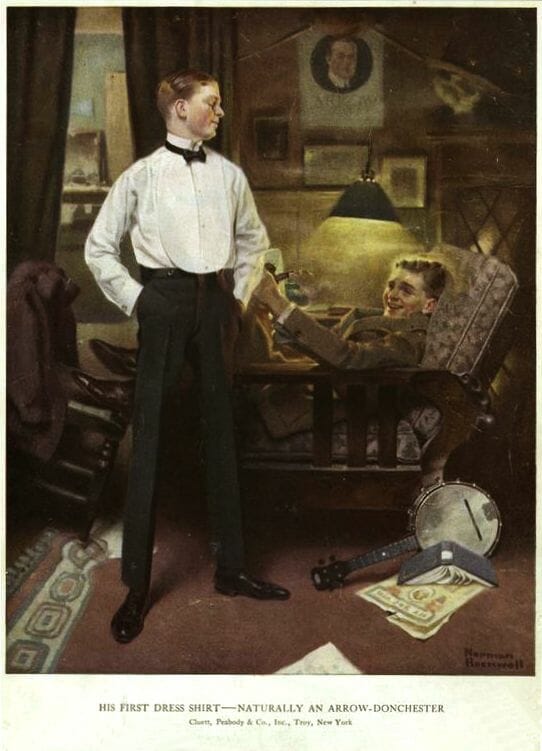
see “stiff-front shirt“
Box Pleat (vintage)
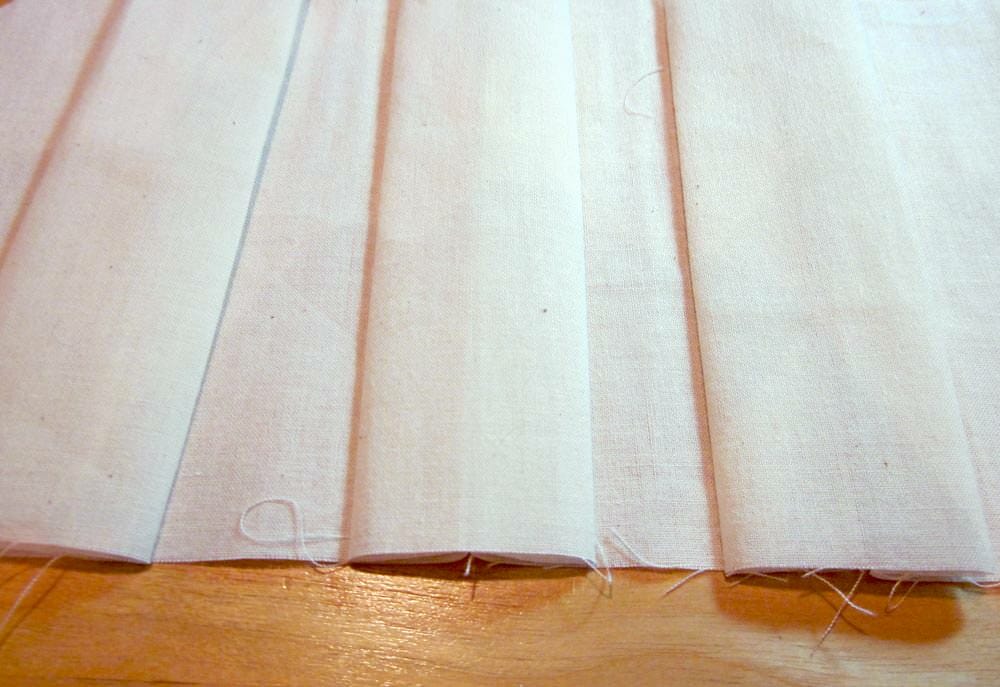
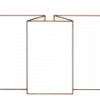
a pleat style featuring two straight fabric folds facing in opposite directions; often featured on the bosom of classic turndown collar shirts
Blade
the shaped ends of an untied bow tie; when the center of a blade is knotted during the tying process two “wings” are created
Bosom
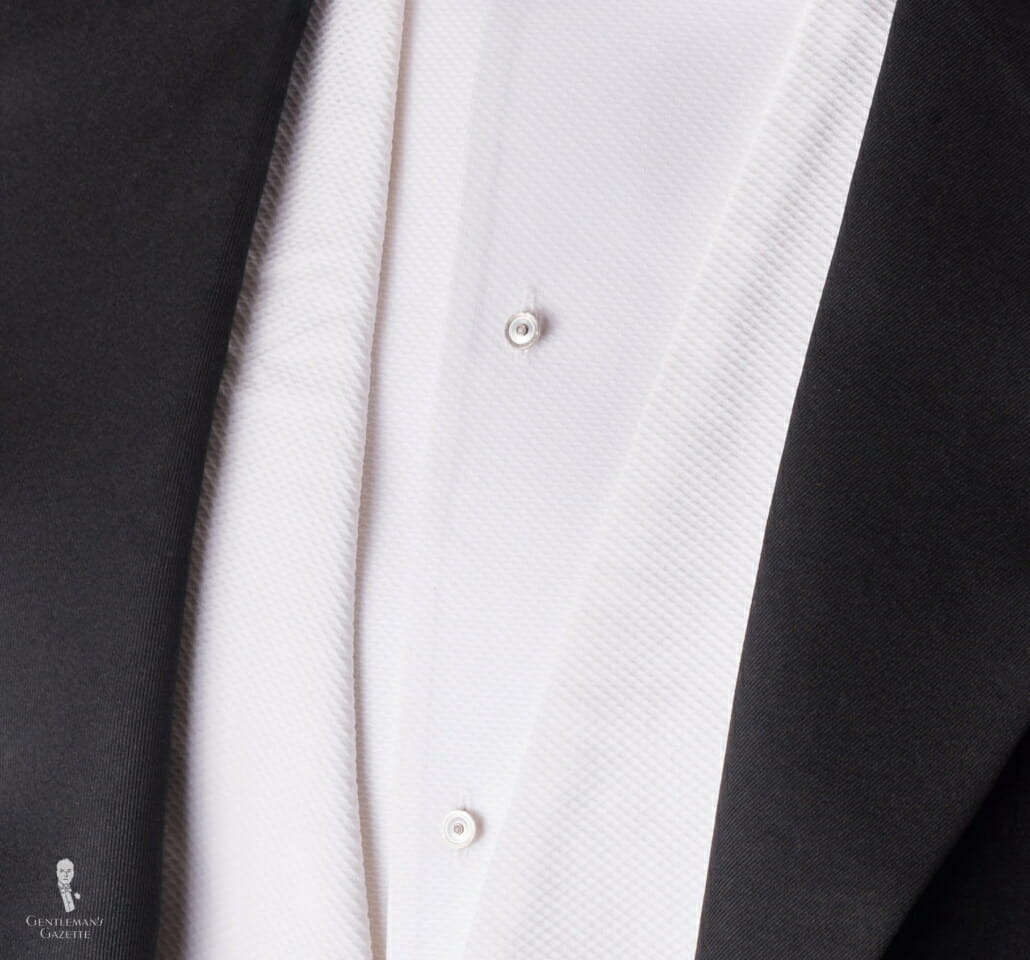
the reinforced front portion of a formal shirt that is visible when the shirt is worn with a jacket; usually starched material in either plain or textured finish (especially piqué) or soft with pleats; also known as a “bib“
Boutonniere
a flower or bouquet worn in a buttonhole; from French “boutonnière” (“buttonhole”); pronounced boo-ten-YARE (most correctly) or boo-ten-EAR; known as a “buttonhole” in the UK
Braid
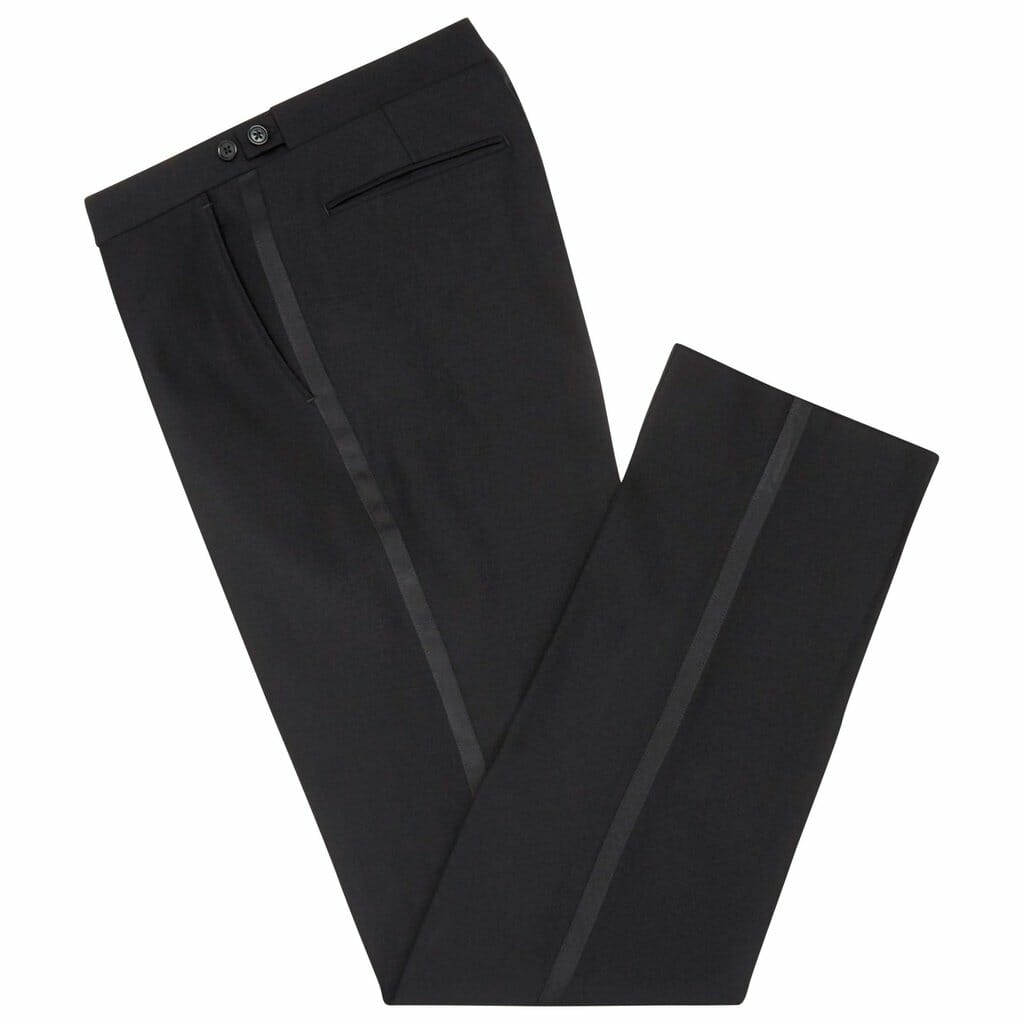
when used in the context of formal trousers, “braid” refers to a stripe of dressy facing that covers the outside seam of the legs and may or may not include actual braid; also see Galon
Broadcloth
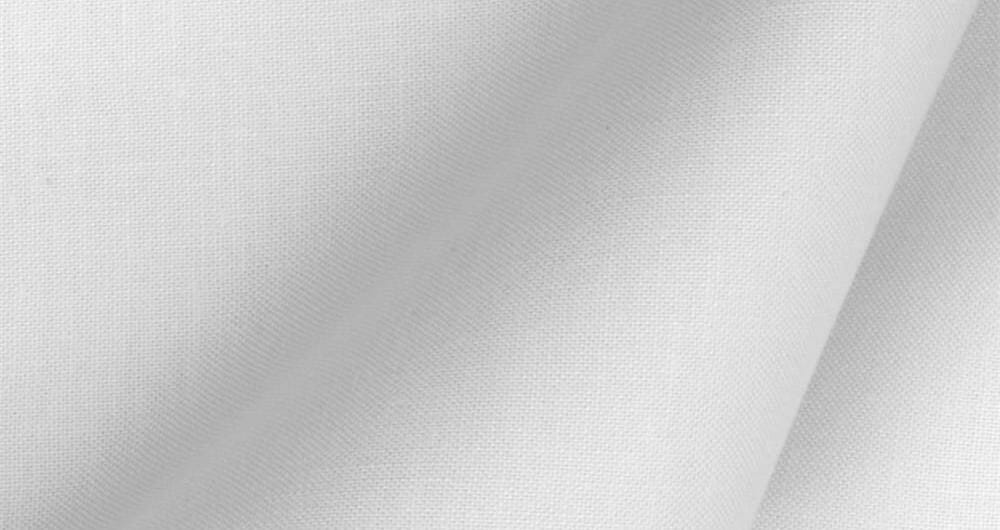
a fabric usually of cotton, silk, or rayon made in plain and rib weaves with a soft semi-gloss finish
Brocade
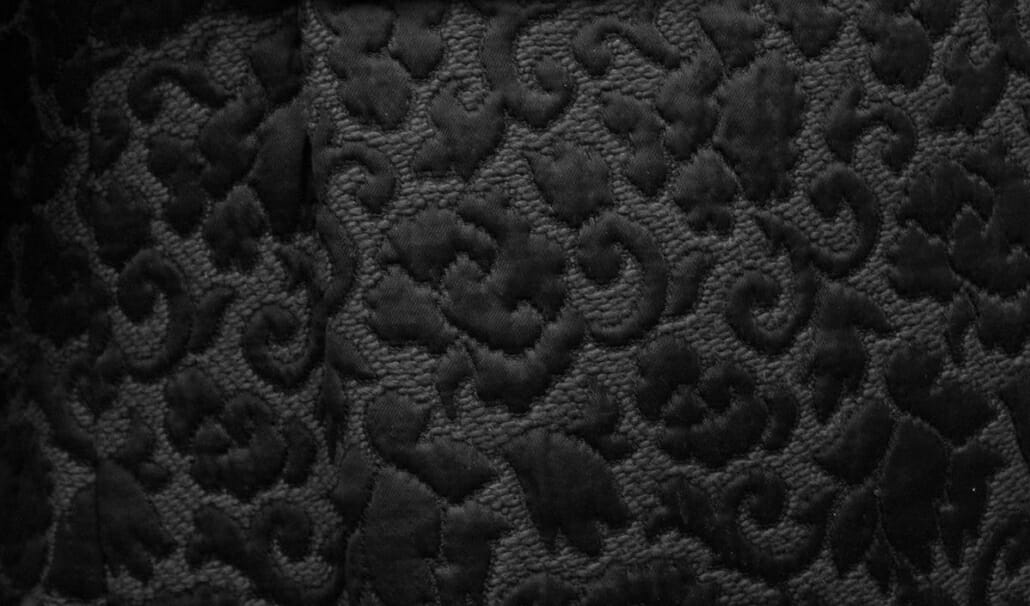
a jacquard fabric characterized by raised figures or flowers; sometimes used for formal silk waist coverings or facings. See jacquard.
Buckskin
the skin of a buck (male deer) or a soft pliable leather usually with a suede finish; used for formal outdoor gloves
Butterfly Bow Tie
bow tie a bow tie with thistle-shaped blades that create flared, slightly curved wings; wing ends can be straight or pointed; straight-end version also known as a “thistle bow tie” (esp. in the UK); compare to a batwing bow tie
Button Stance
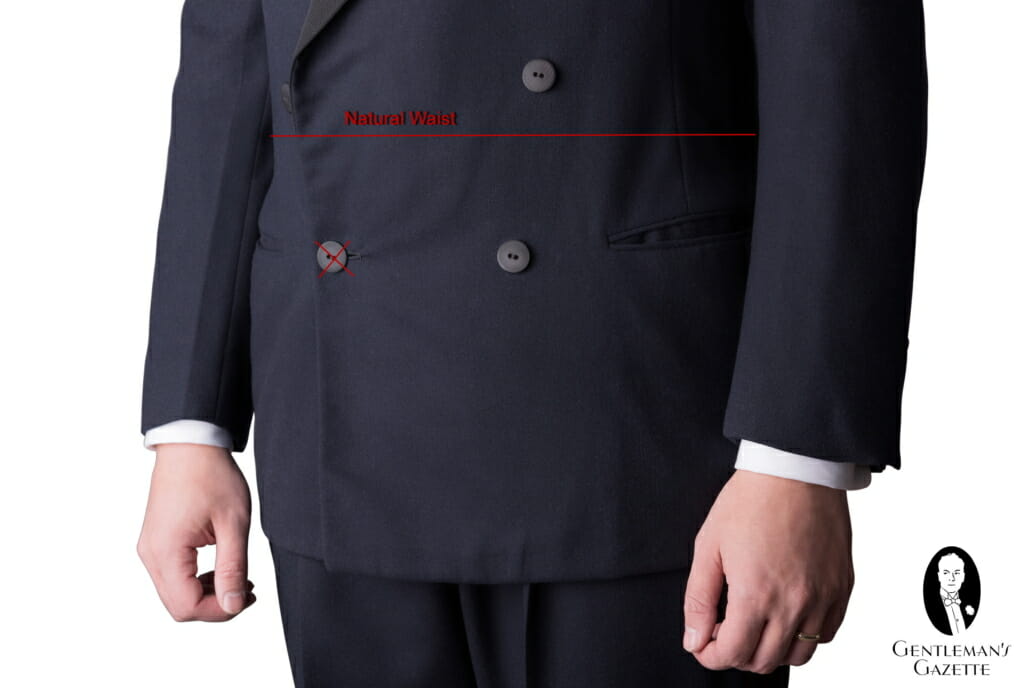
the location of a coat’s front buttons relative to its waist
Calfskin
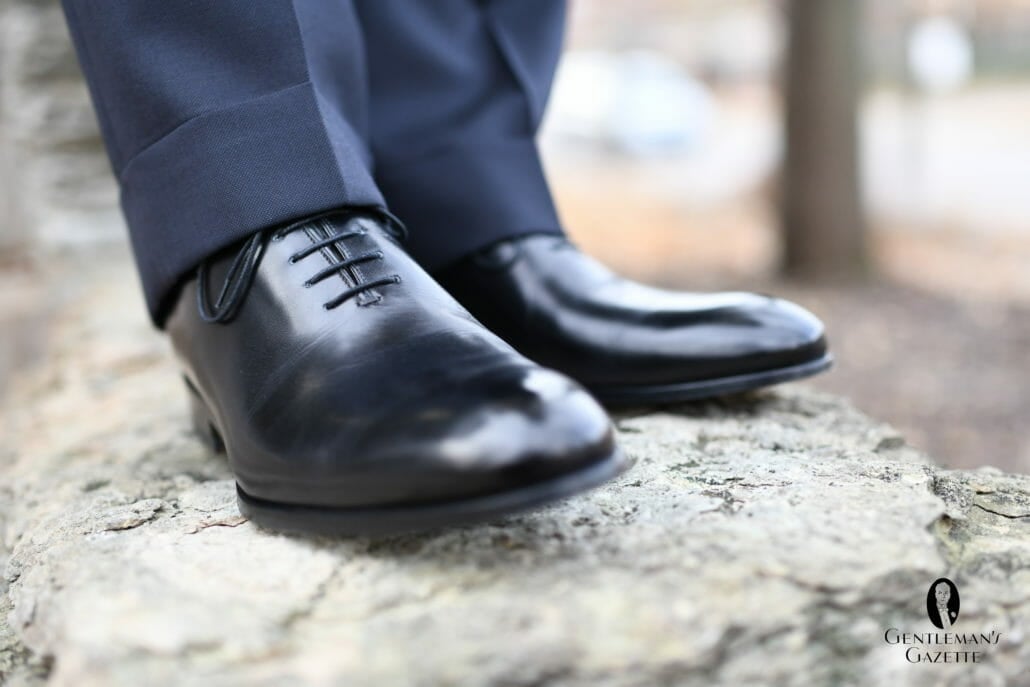
a fine leather made from the skin of a young calf; alternative to patent leather in formal footwear
Cape
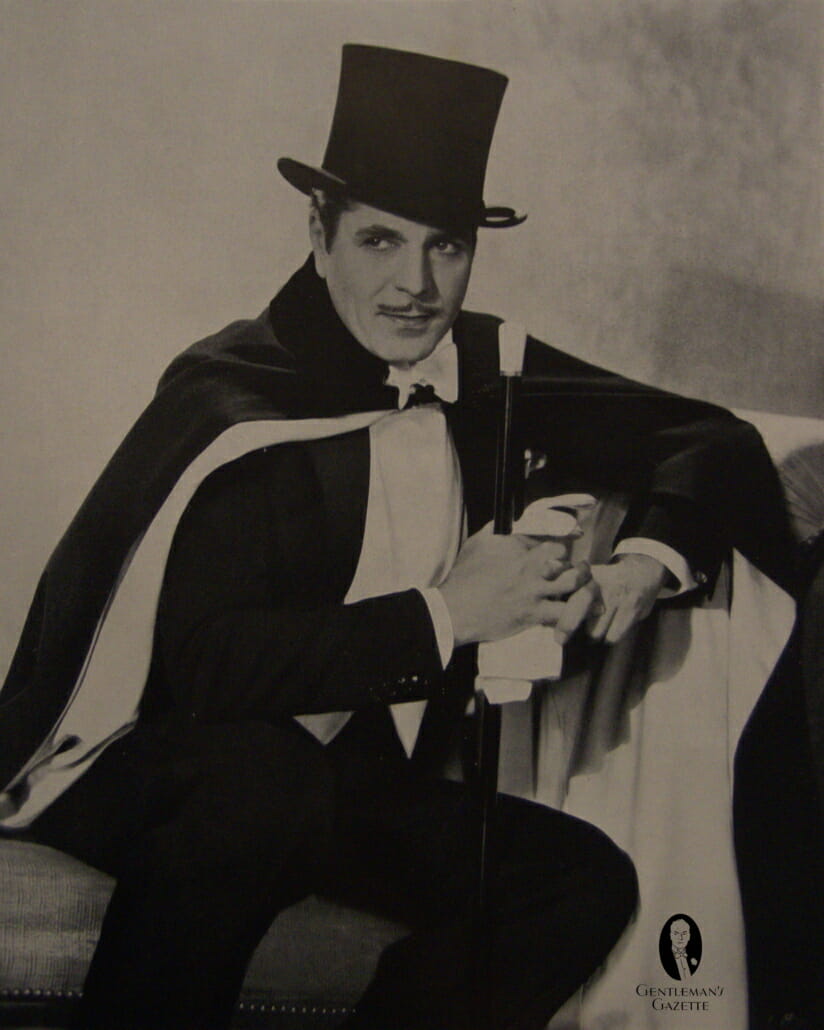
evening outerwear for white tie but also sometimes worn with black tie. lined with silk sometimes in contrasting white. , often part on an Inverness. ; also known as cloak
Cashmere
a fine wool from the undercoat of the Kashmir goat woven or knitted into soft fabrics that are luxurious to the touch
Cloak
see “cape“
Clock

a knitted, woven or embroidered vertical design on the outside of a sock
Club Bow Tie
see “batwing bow tie“
Continental Tie
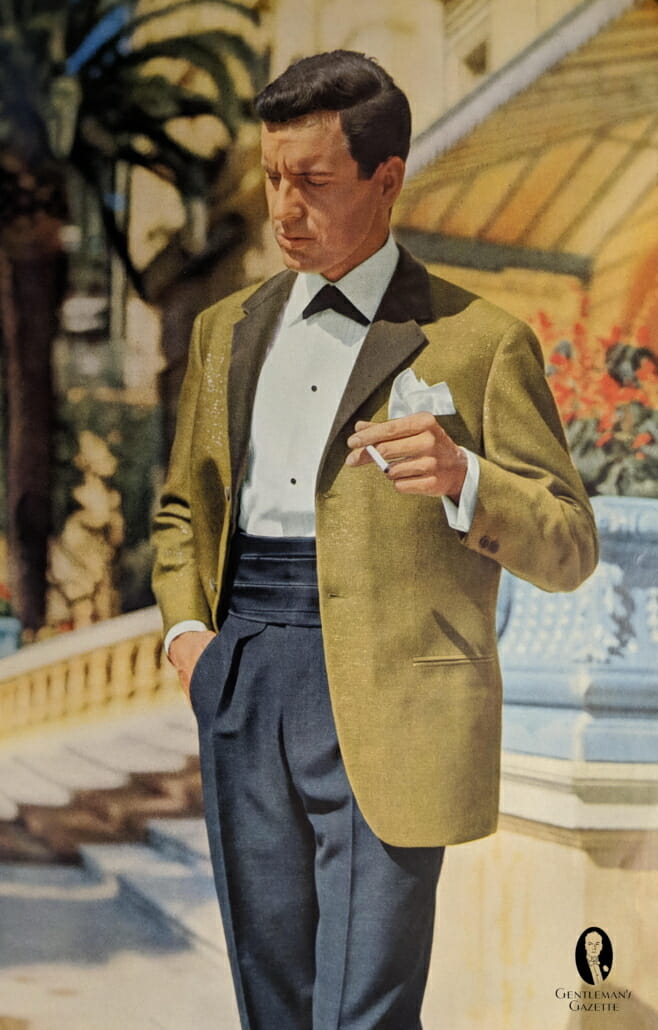
a bow tie alternative consisting of a strip of black fabric that overlaps under the throat where it is is fastened by a tie tack or snap button; the term is also applied to a V-shaped neckband fastened behind the neck; neither are considered proper black tie
Cufflinks
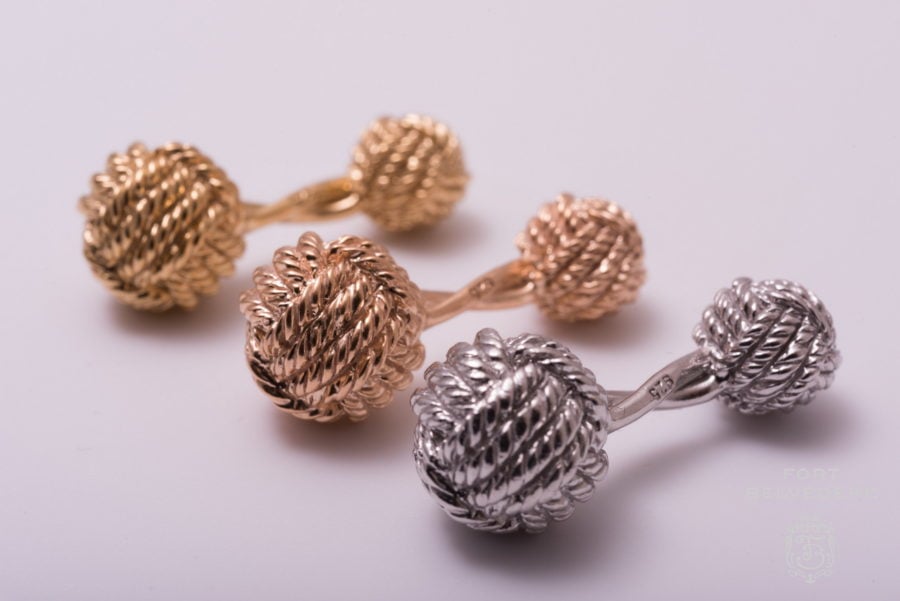
a usually ornamental device consisting of two parts joined by a shank, chain, or bar for passing through buttonholes to fasten shirt cuffs; required for formal shirts
Cummerbund
a broad pleated waistband or sash usually worn with a tuxedo in place of a waistcoat; became popular in the 1930s; from Hindi & Urdu kamarband in turn from Persian, from kamar waist + band band
Cutaway (coat)
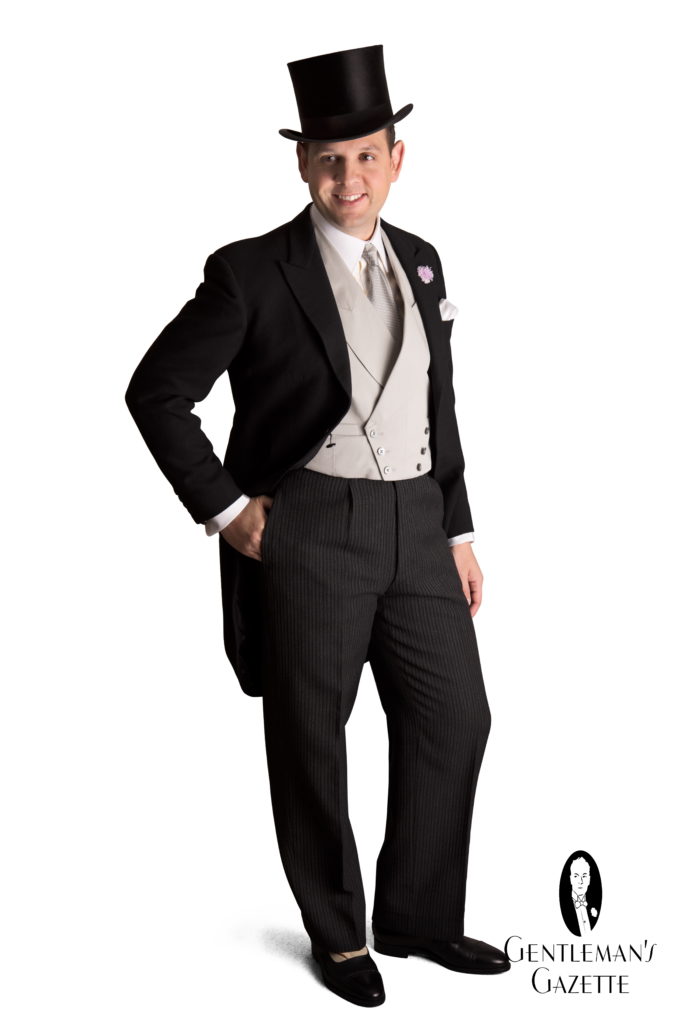
see “morning coat” and morning dress guide
Cutaway Collar
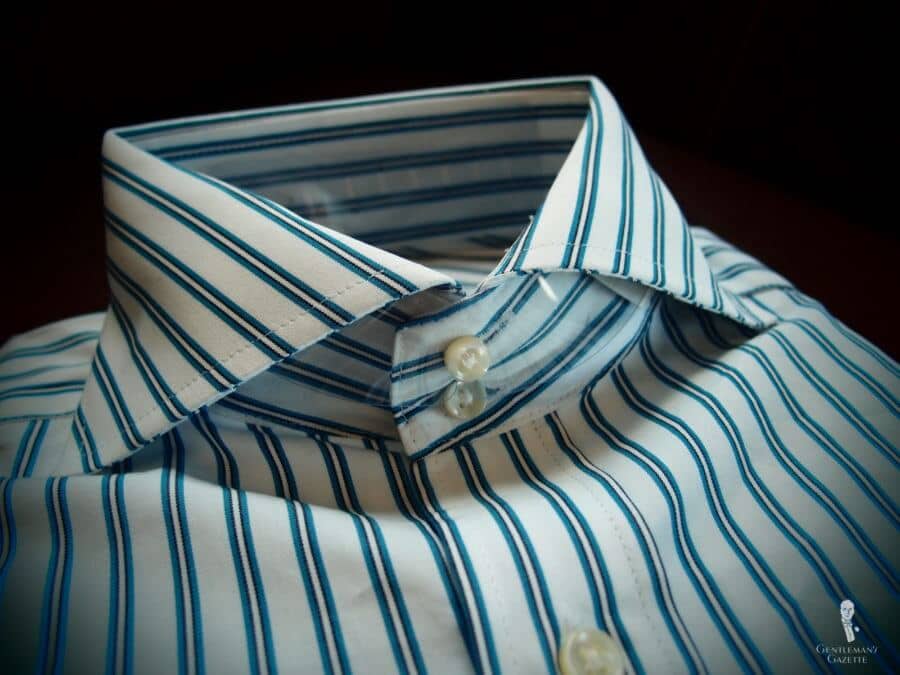
a spread collar with an extremely wide spread between the collar points
Detachable Collar
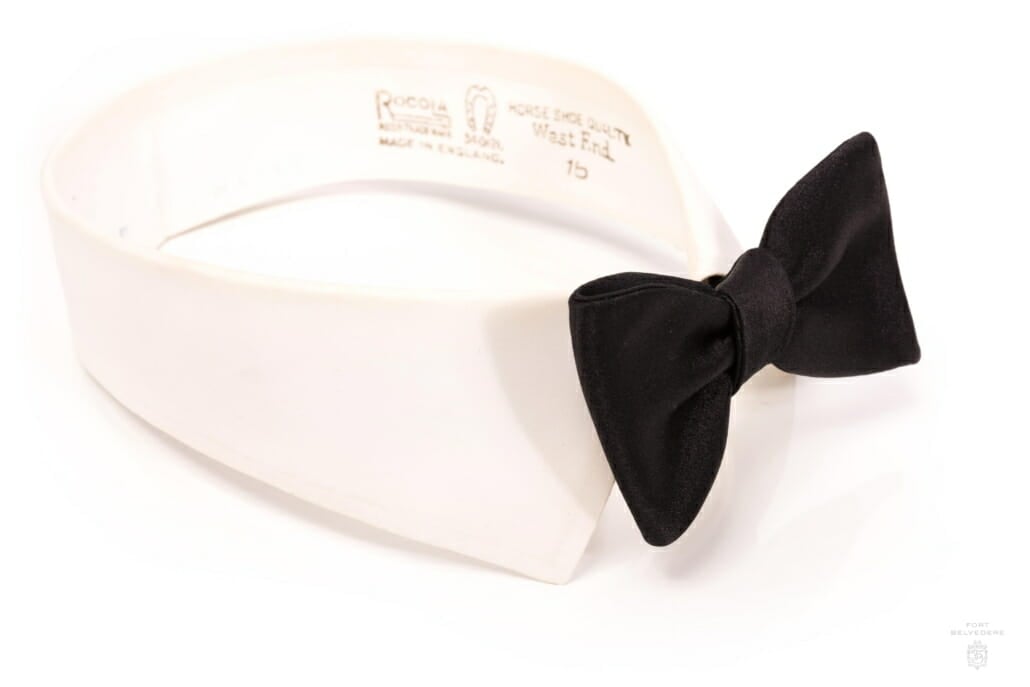
a collar attached to a collarless shirt by means of studs; usually made of highly starched cotton; in formal wear usually a wing collar attached to a stiff-front shirt; compare to attached collar
Dinner Jacket
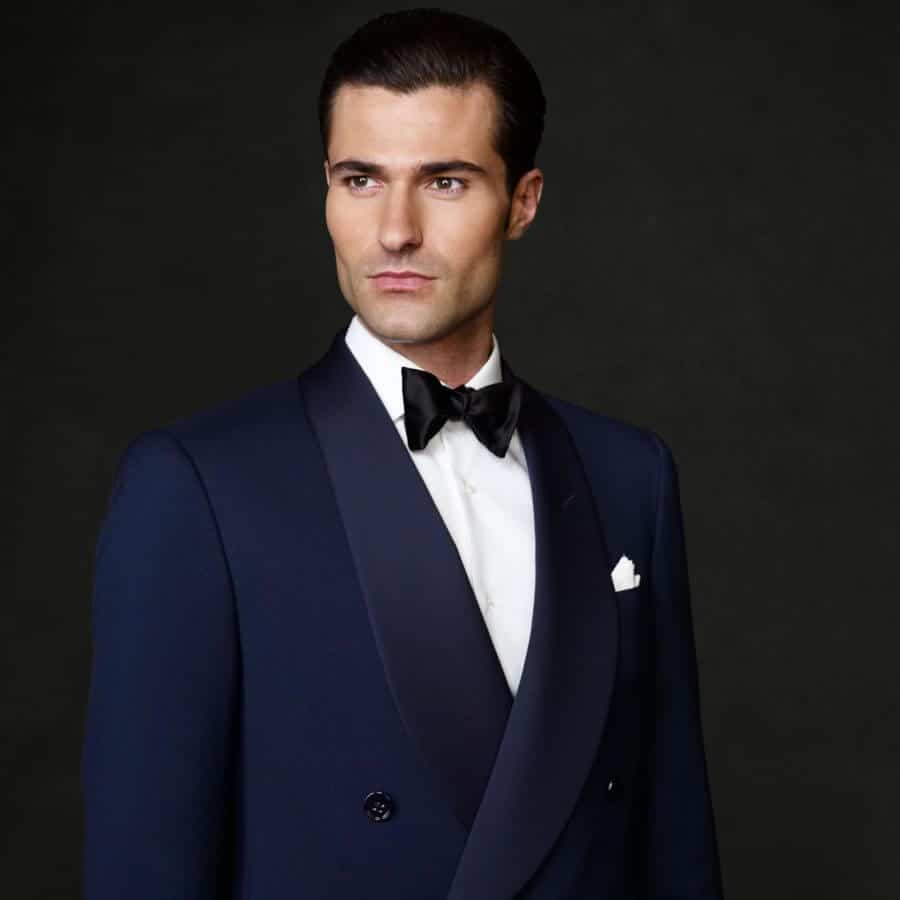
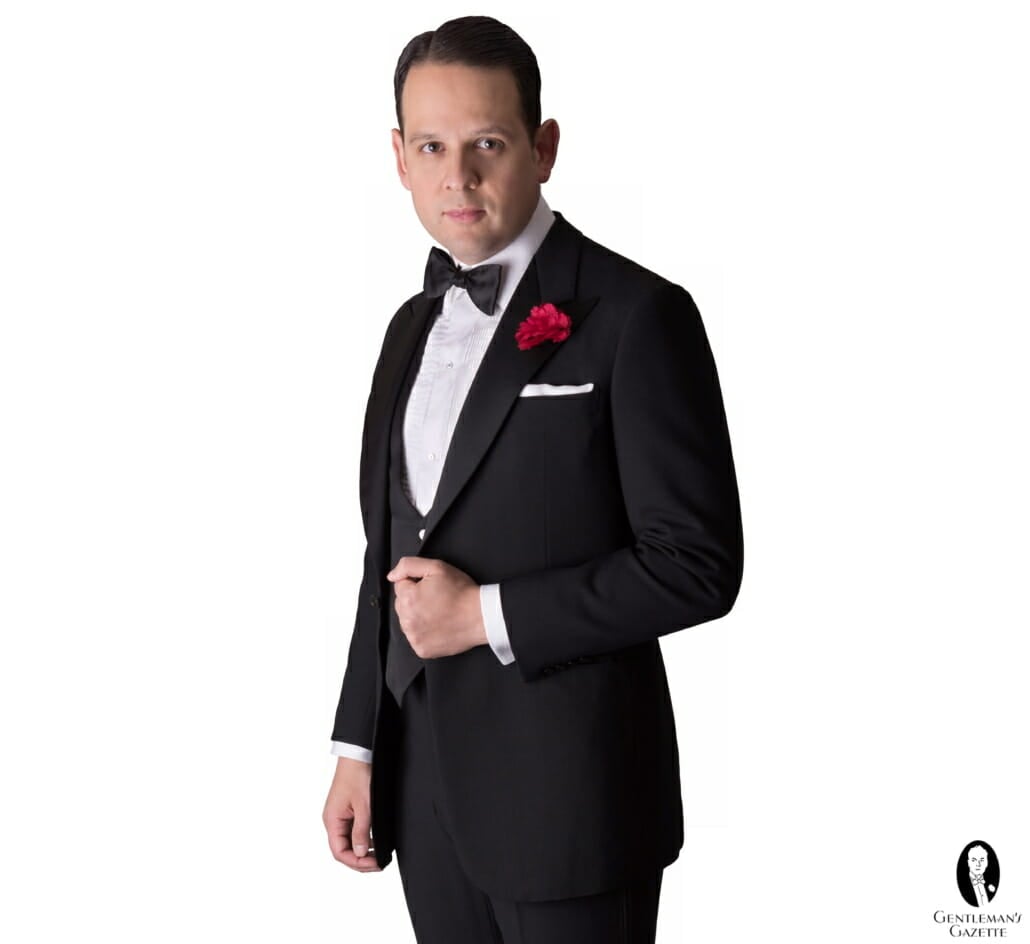
a usually black or midnight blue formal suit jacket with dressy lapel facings for evening wear; also known as a tuxedo jacket may also come in different colors such as bottle green, burgundy, bronze or dark blue – see Comparative Terminology
Double-Breasted
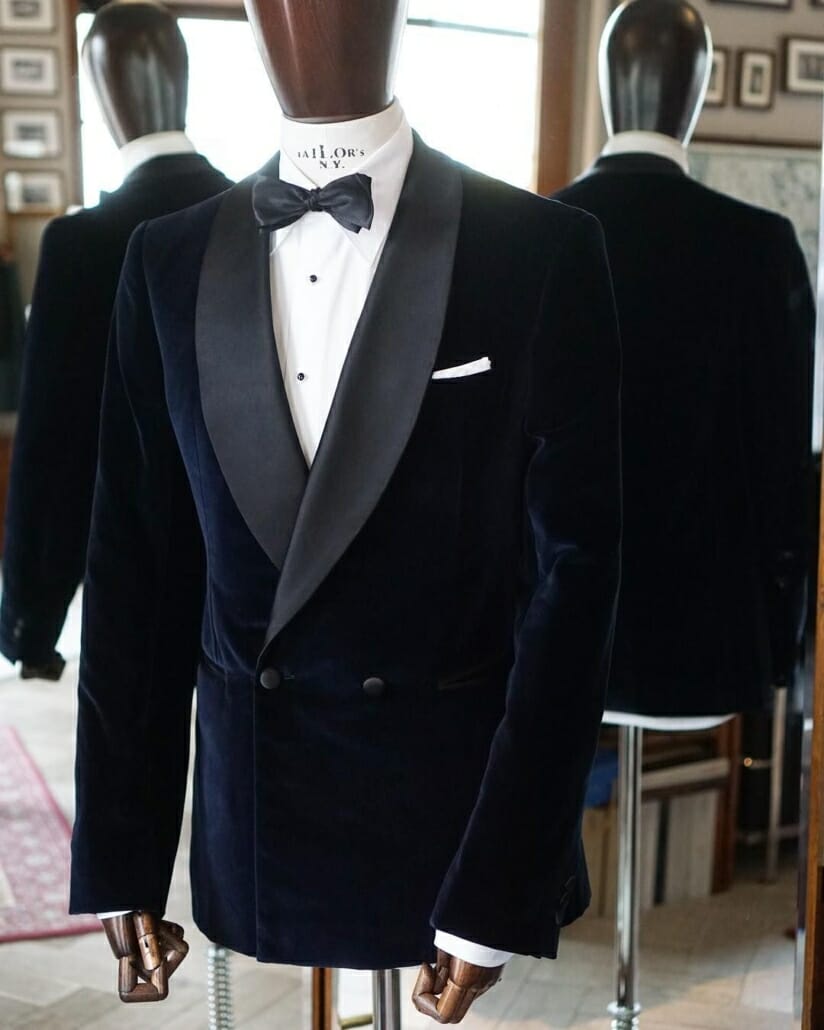
having one half of the front lapped over the other and usually a double vertical row of buttons and a single row of buttonholes; found in jackets, coats, overcoats and waistcoats; compare with single-breasted
Double Cuff
see “French cuff“
Dress Coat
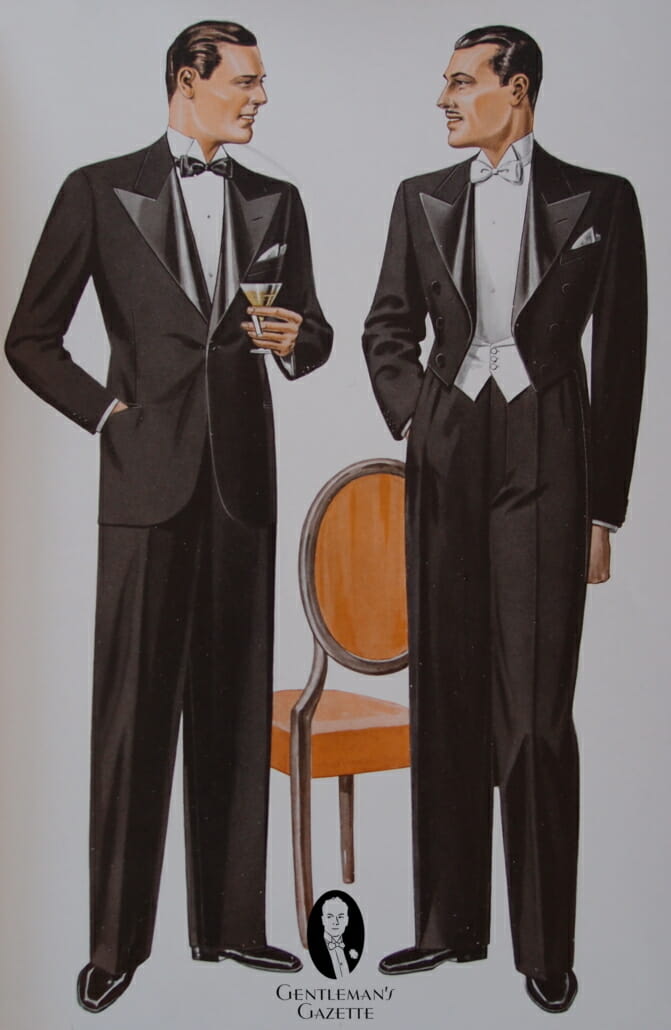
chiefly British term for evening tailcoat
Dress Suit
chiefly British term for evening tailcoat and matching trousers aka“full-dress suit“; compare with “dinner suit” which refers to dinner jacket and matching trousers
Duck (vintage)
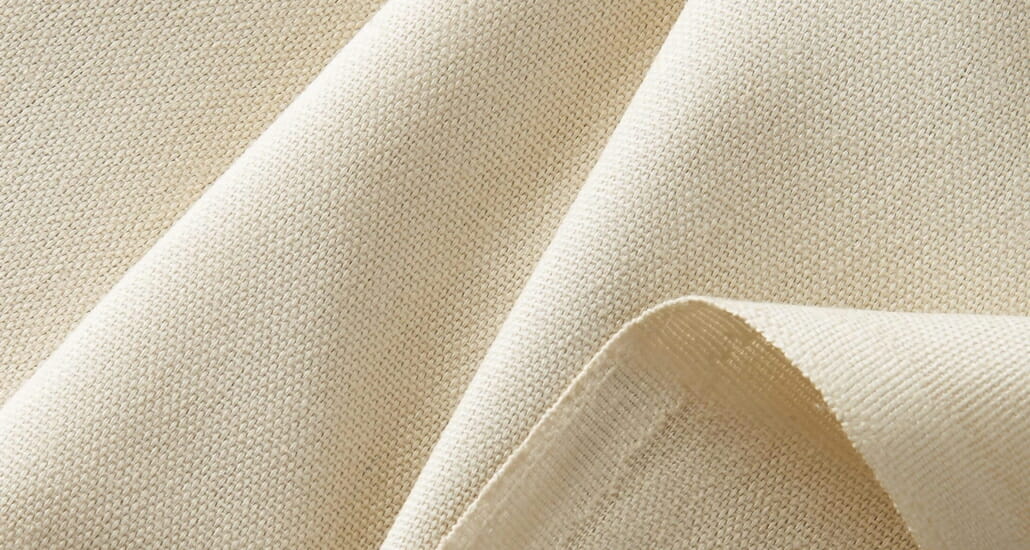
a heavy, plain woven cotton fabric commonly referred to as “canvas”; also known as “cotton duck”, “duck cloth” or “duck canvas”; from Dutch “doek” (“linen canvas”)
Embroidery (vintage)
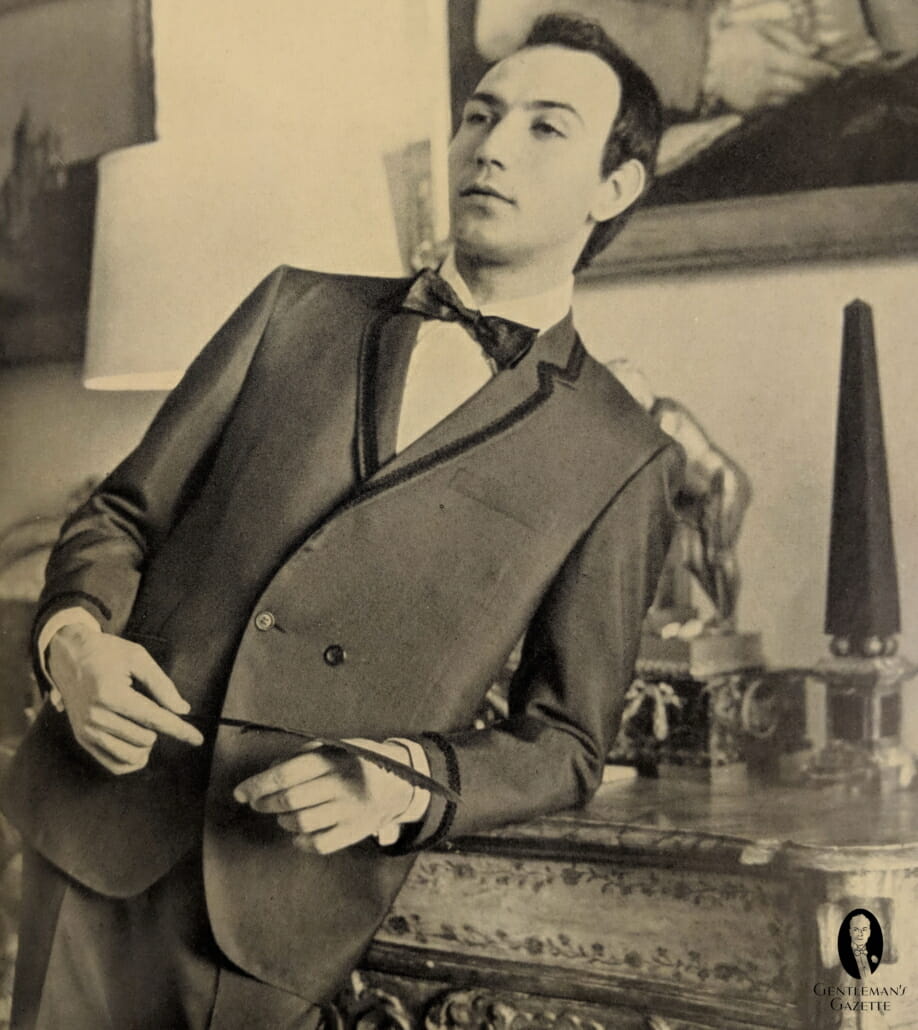
ornamented with needlework; sometimes found on formal soft shirts and facings in the ’50s and ’60s
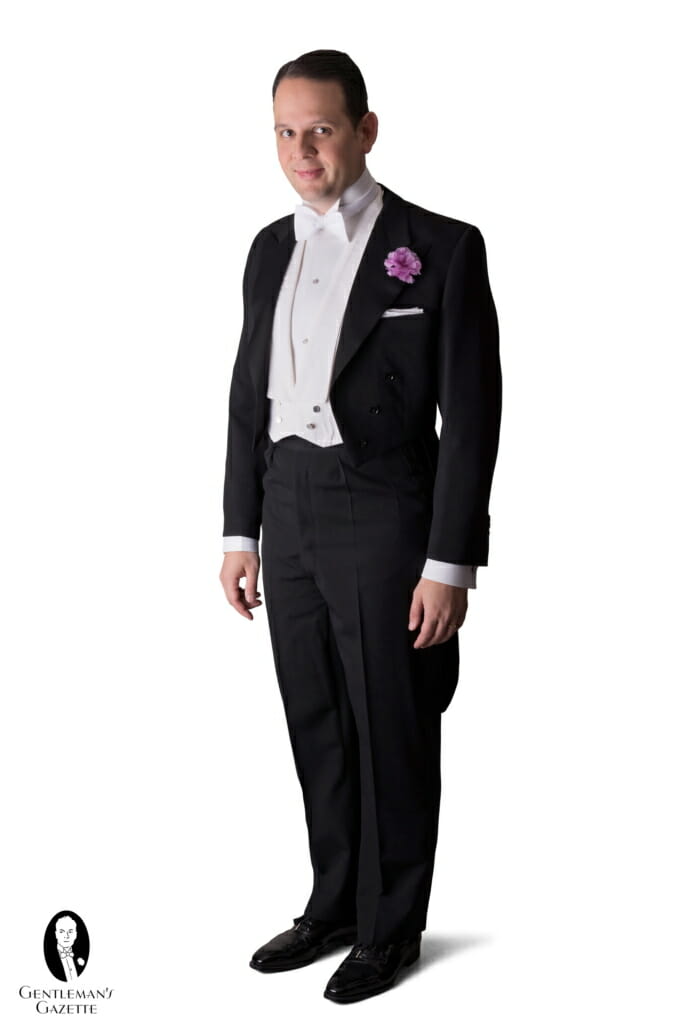
Evening Tailcoat
a tailcoat that is double-breasted (although designed not to close) with skirt sharply cut away at the front
Evening Wear
Eyelet
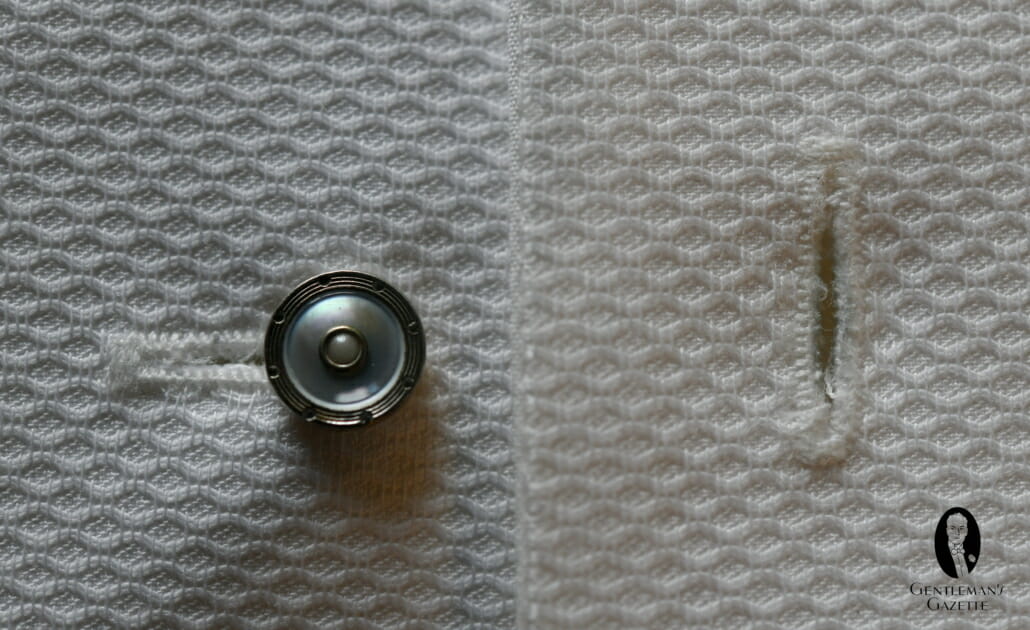
in regards to formal wear, a button hole intended to take a stud; also known as a “stud hole”
Facing
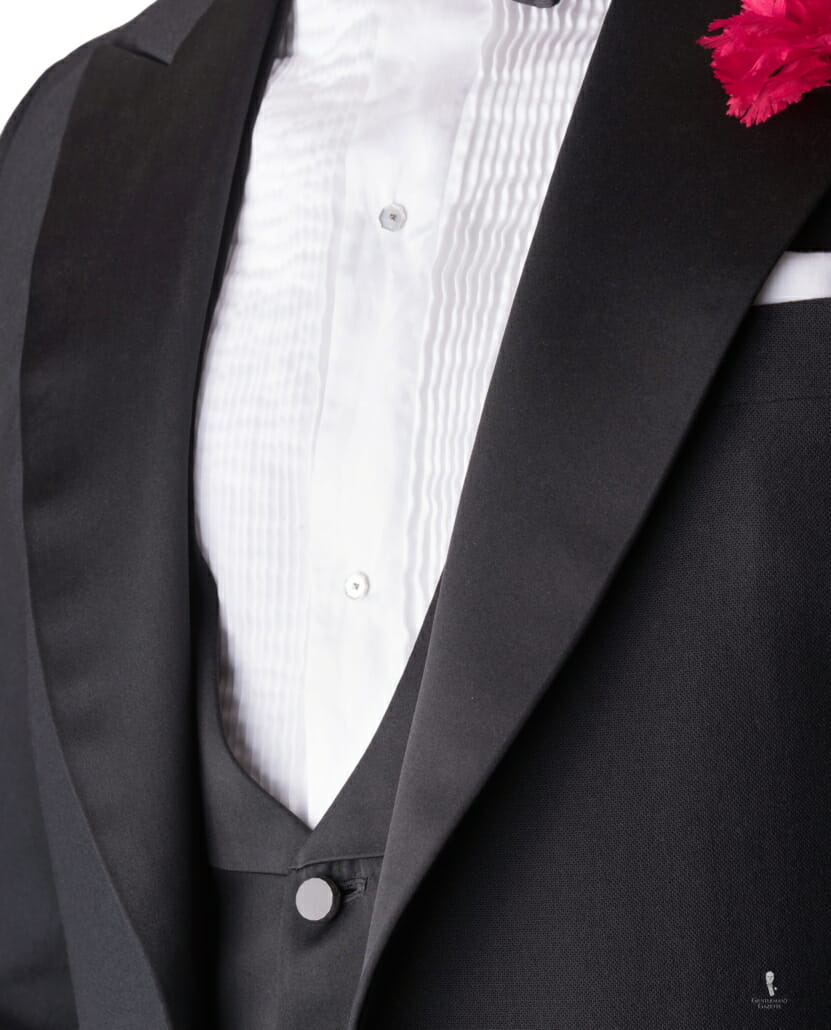
a layer of decorative fabric used to dress formal accents such as dinner jacket lapels, buttons, and welts, as well as to cover trouser seams
Faille
a somewhat shiny, closely woven silk, rayon, or cotton fabric with a ribbed weave; used in formal wear facings and bow ties; pronounced FILE (note: term is often used interchangeably with grosgrain although it is actually finer finish)
False Cuff (vintage)
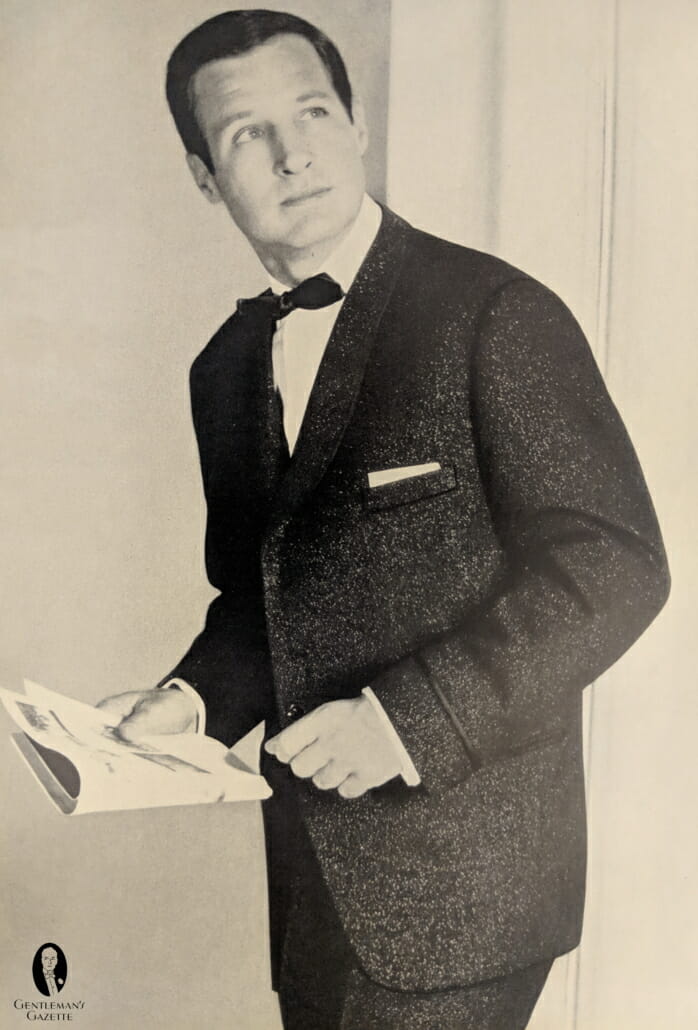
false cuff tailoring embellishment that creates the impression of a finished sleeve cuff; popular on formal coats in the Victorian era
Finished Waistband
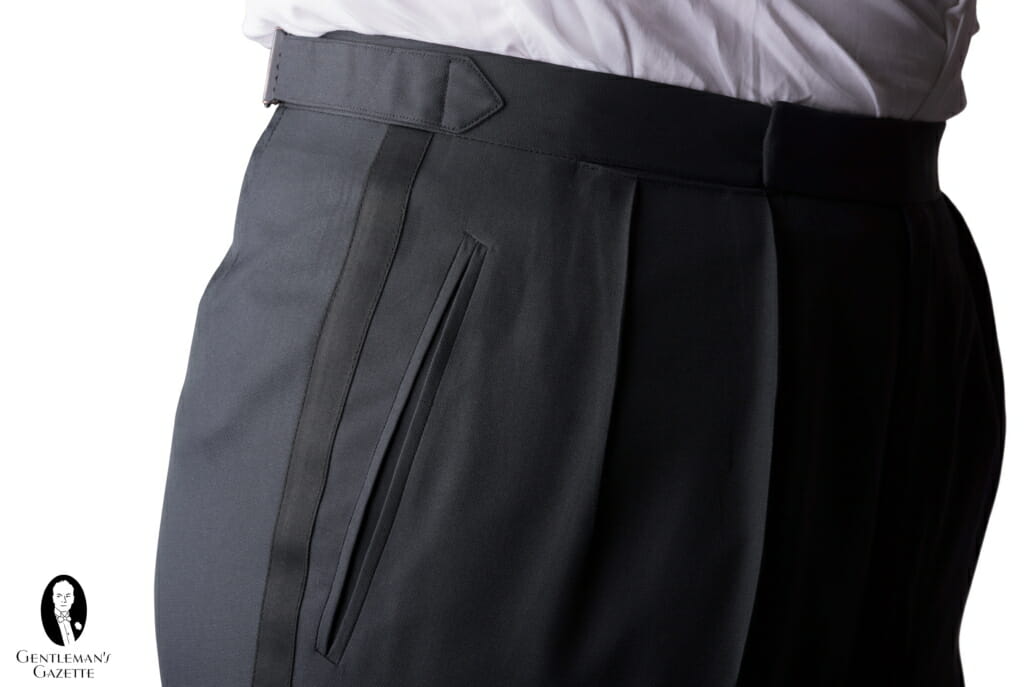
a formal trouser waistband dressed with decorative facing and uninterrupted by belt loops; designed to be worn without a waist covering; became popular in the 1990s

Flap Pocket
an inset pocket with a covering (flap) over the mouth; considered less formal than a jetted pocket which does not have a flap
Fly Front
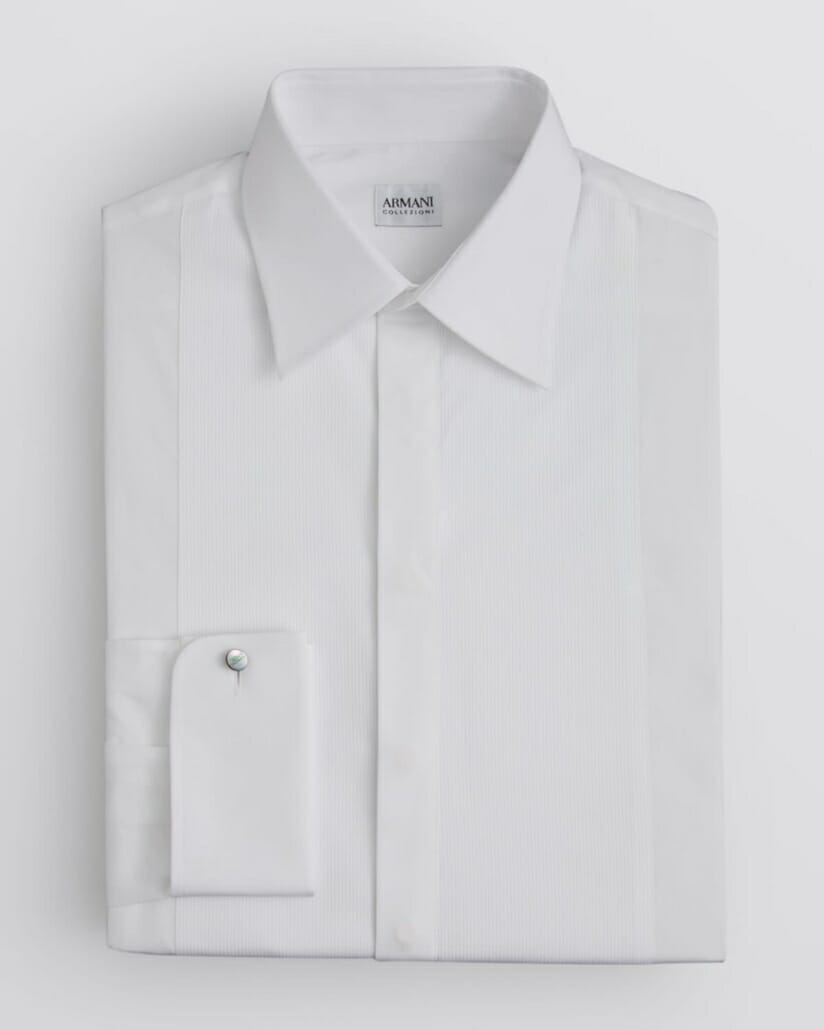
a closure in which a placket or piece of fabric covers buttons or a zipper; used on a shirt, coat or trouser
Formal
see Dress Codes
Four-in-hand
the knot most commonly used to tie a long necktie; also refers to the long tie itself; black silk four-in-hand ties are sometimes used as a fashion-forward alternative to the bow tie
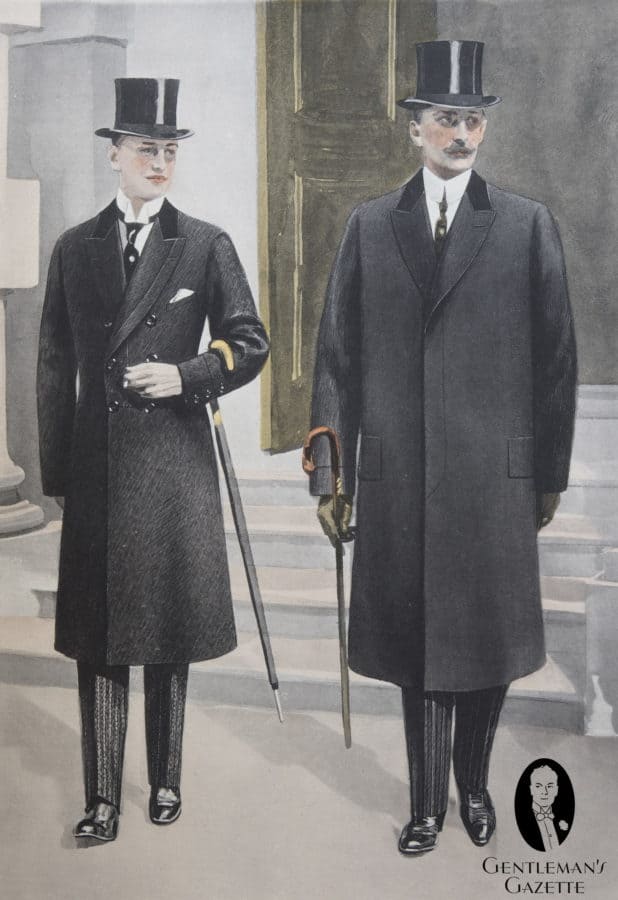
Frock Coat
historically a man’s knee-length double-breasted day coat (often known as a Prince Albert coat); since the 1990s, a fashion-forward alternative to the dinner jacket not considered proper black tie
French Cuff
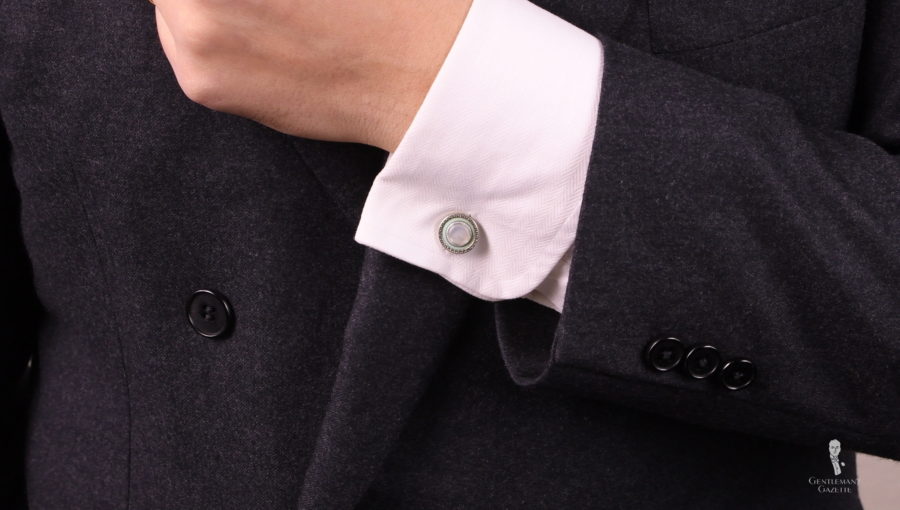
a soft double cuff that is made by turning back half of a wide cuff band and fastening it with cuff links; found on soft-front formal shirts; also known as a “double cuff” (esp. in the UK); compare with single cuff
Full Dress
original term for what is now known as white tie; originally distinguished from “half dress” (semi-formal day and evening wear) and “undress” (lounge suit) (note: written as “full-dress” when used as an adjective)
Galon
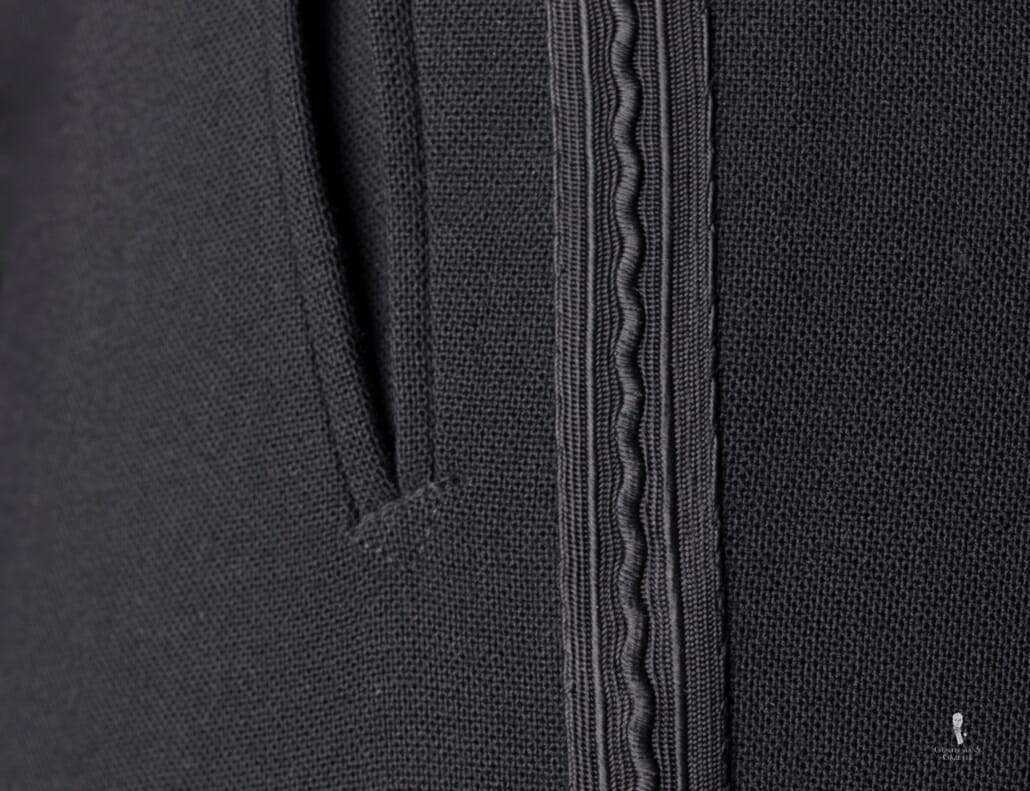
when used in the context of formal trousers, “galon” refers to a single (for black tie) or double (for white tie) stripe of dressy facing that covers the outside seam of the legs and may or may not include actual braid; also see braid
Grosgrain
a strong close-woven corded fabric usually of silk or rayon; used as a more understated alternative to satin facing in formal wear; pronounced GROW-grain. Also see faille
Homburg
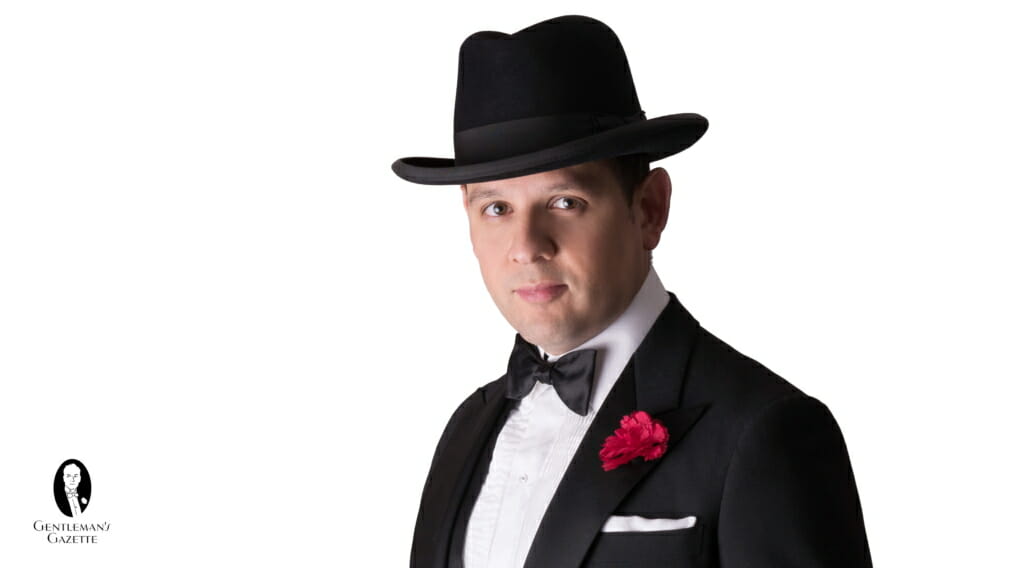
a man’s felt hat with a stiff curled brim and a high crown creased lengthwise; appropriate in black for black-tie attire since the 1920s
Inverness
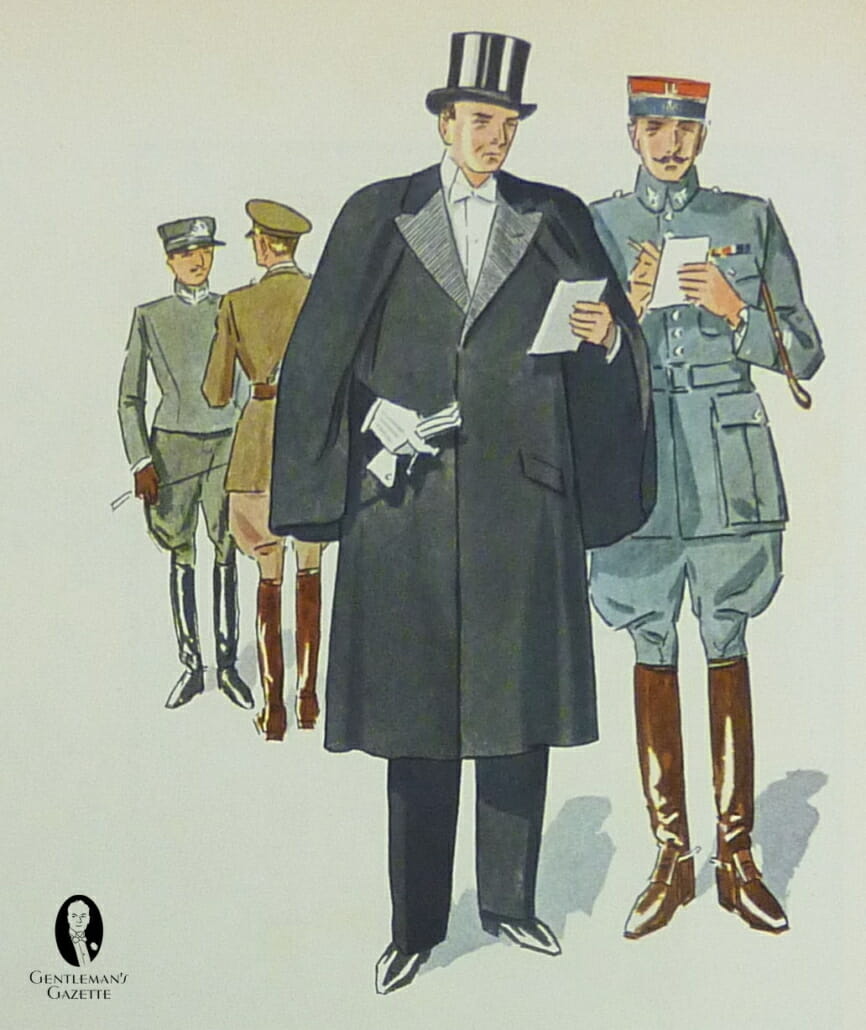
overcoat with cape that was a prefered choice over overcoat for white tie and also black tie during the Victorian, Edwardian Age as well as 1920s and 1930s.
Jacquard
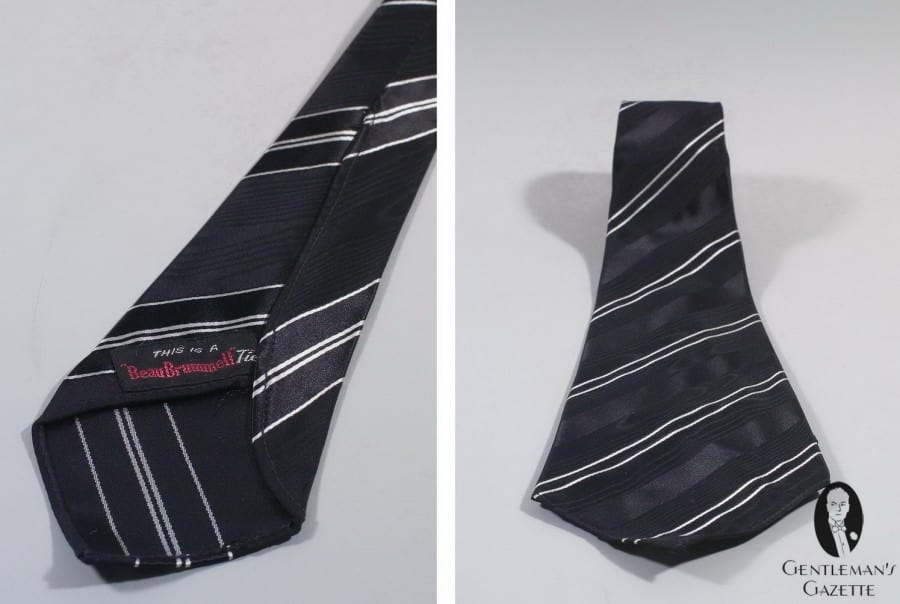
a fabric of intricate variegated weave or pattern; named for the Frenchman who invented the loom; sometimes used for formal facings and waist coverings; pronounced JA-kard
Jetted Pocket
see “besom pocket“
Lawn (vintage)
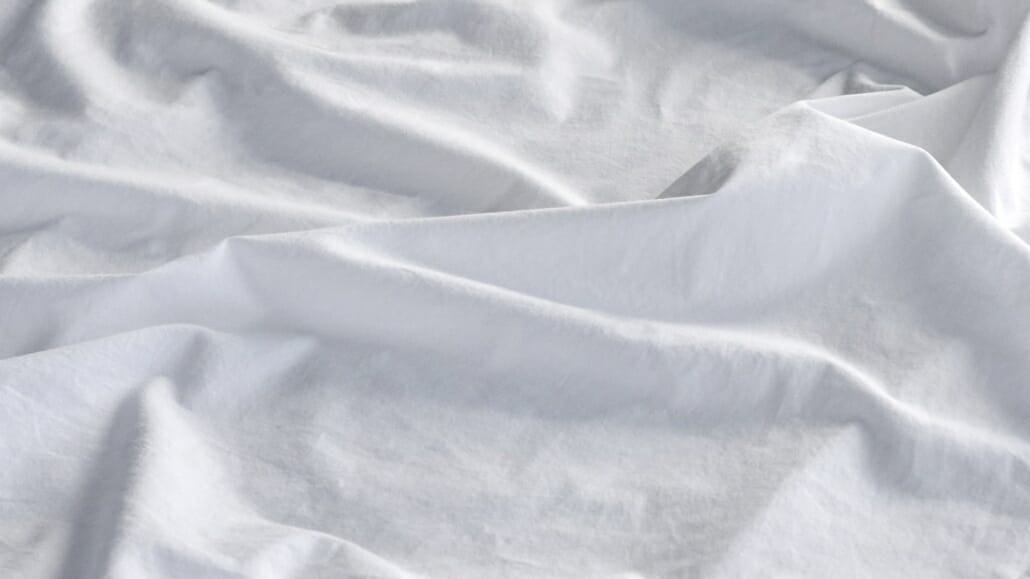
a fine sheer linen or cotton fabric of plain weave; originally used for full-dress bow ties
Laydown Collar
see “turndown collar“
Link Front
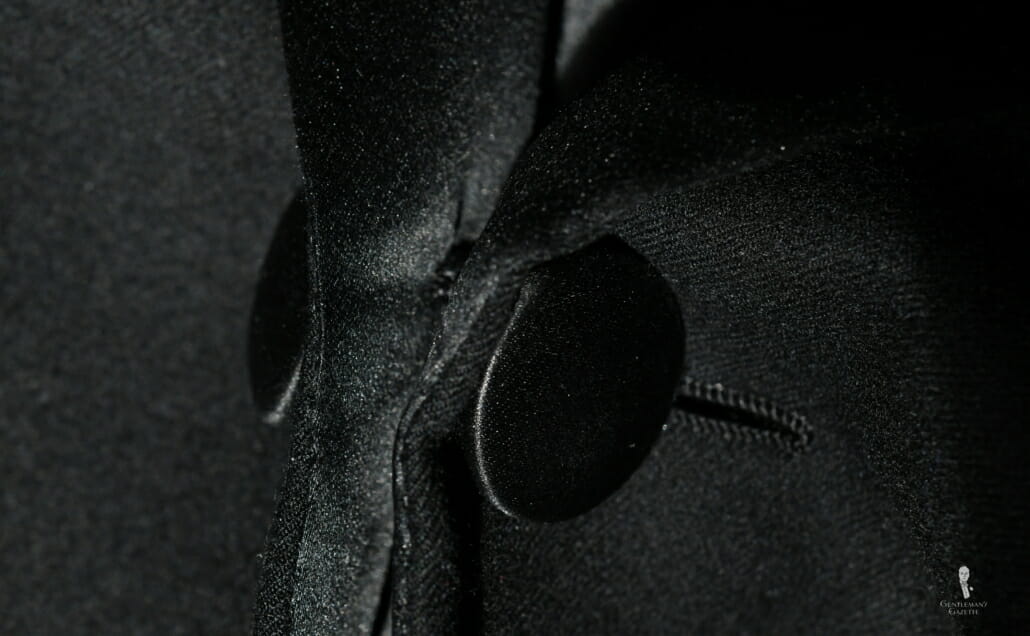
method of fastening a single-button jacket with two buttons connected to each other cufflink-style; a very traditional style for morning coats but also sometimes seen on dinner jackets both past and present
Lisle

a smooth, sleek, tightly twisted thread usually made of long-staple cotton; used as an alternative to silk for formal socks.
Lounge Suit
British term for the business suit; named after its original role as Victorian resort, casual or lounge wear.
Madras (vintage)
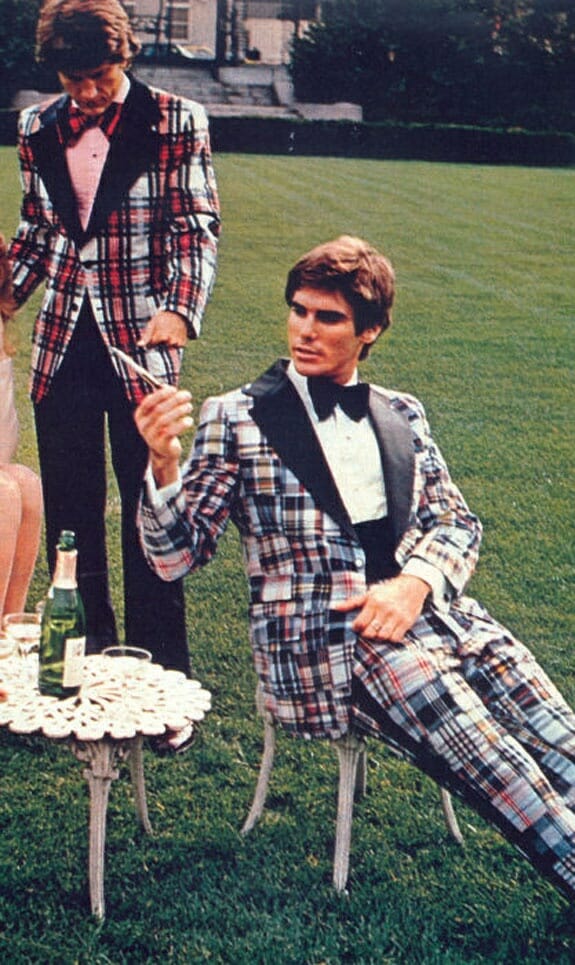
a fine plain-woven shirting and dress fabric usually of cotton with varied designs (as plaid) in bright colors or in white; used for fashion-forward black tie in the 1960s
Marcella

a type of piqué weave historically considered distinct from piqué but now usually considered synonymous; in the UK also a black-tie shirt with bosom, turndown collar and/or cuffs in white piqué with body and sleeves in white voile or broadcloth
Maroon

a popular color for waist coverings (especially cummerbunds), bow ties and accessories from the 1930s to the 1950s, particularly in summer
Mess Jacket
a white military dress jacket cut just above the waist that was adapted for civilian semi-formal wear in the early 1930s. Also see Military Formal Attire – Mess Dress
Midnight Blue
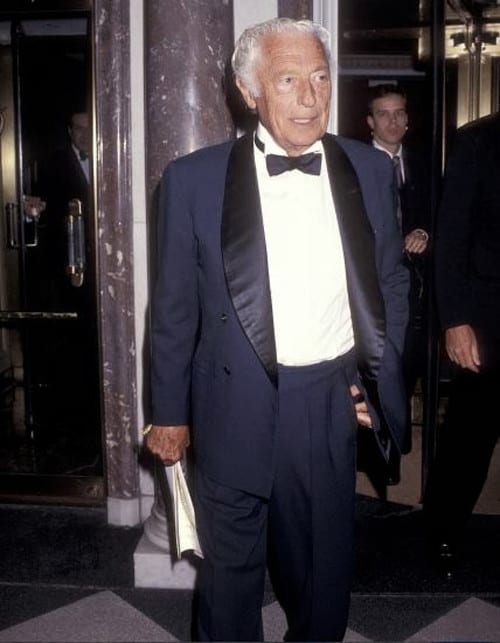
a deep blackish-blue used in evening wear as a richer alternative to black
Mohair
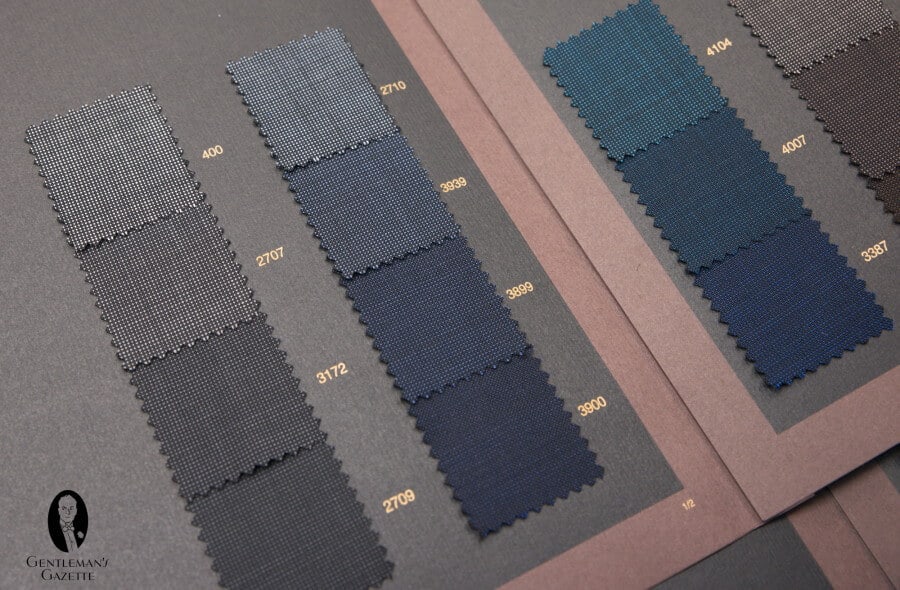
a fabric or yarn made wholly or in part of the long silky hair of the Angora goat; sometimes blended with worsted wool producing a cloth with less sheen but more softness and drape
Moiré
silk, velvet or other fabric having a wavy watered appearance; an independent usually shimmering pattern seen when two geometrically regular patterns are superimposed; mostly in faille or taffeta weaves; used in fashion-forward black-tie fashions in the 1960s; pronounced mwa-RAY
Morning Coat

a tailcoat that is single-breasted and has fronts that curve away gently; the most formal coat for daytime wear; known as a “cutaway” in America
Mother Of Pearl

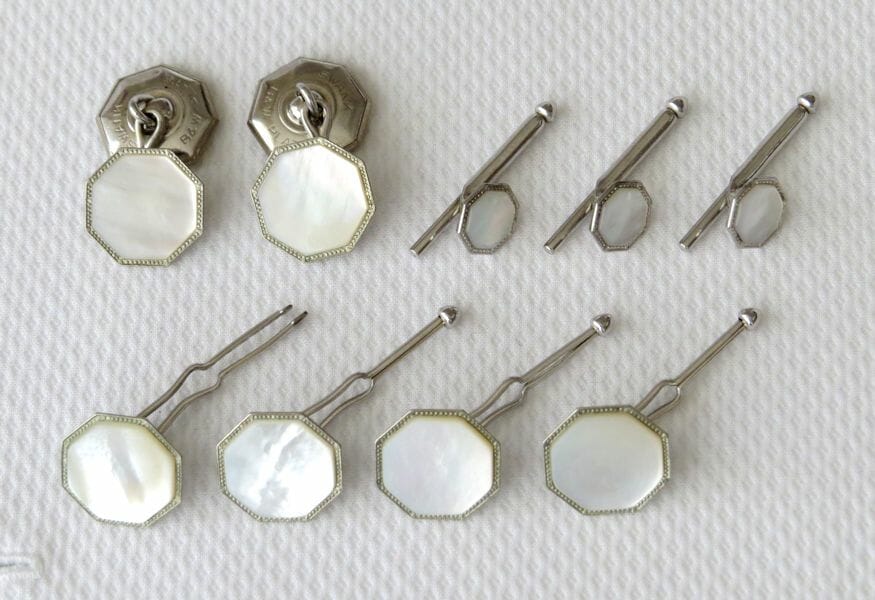
sometimes abbreviated to MOP the hard, pearly, iridescent substance forming the inner layer of a mollusk shell; often used to decorate formal studs and cufflinks
Notched Lapel
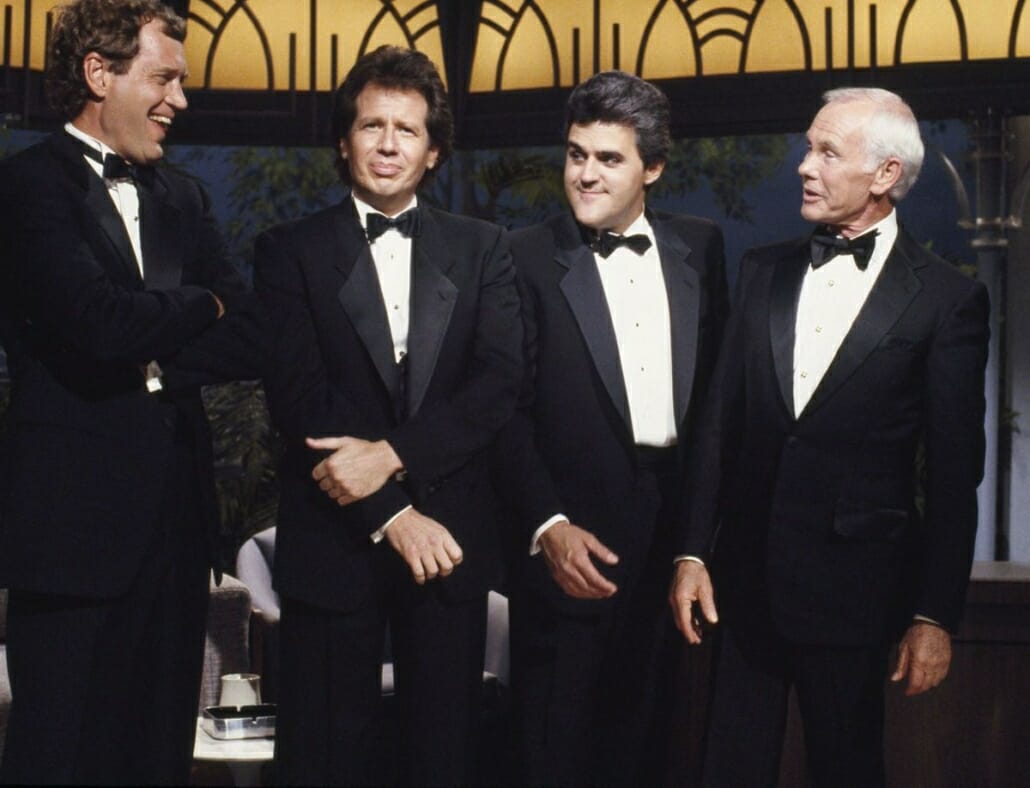
a style of lapel where the top line of the lapel slants down in line with the collar seam; less formal than the peak lapel or shawl collar, it became popular on dinner jackets in the 1960s despite its association with the common business suit
Onyx
a translucent variety of quartz in parallel layers of different colors; often used in black color black-tie studs and cufflinks
Opera Hat
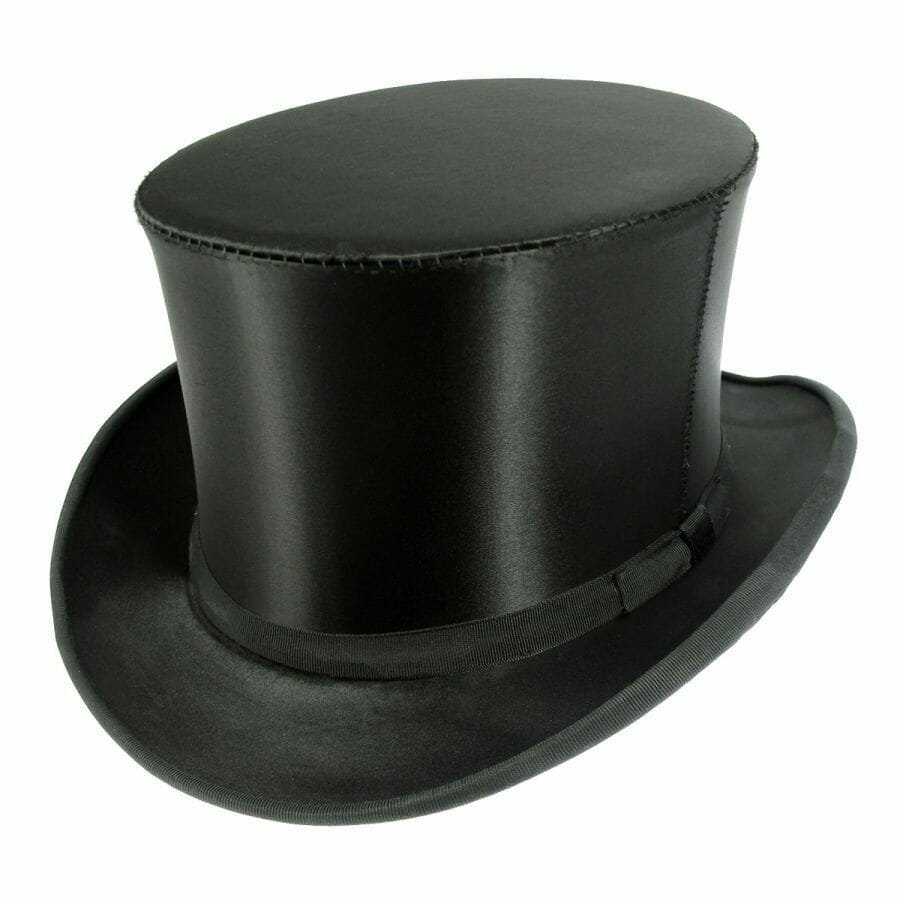
an evening top hat designed to be collapsible for easy storage; not to be confused with a top hat; worn with white tie in the 1930s; also known as a “Gibbus” after its inventor or Chapeau Claque .
Oxford
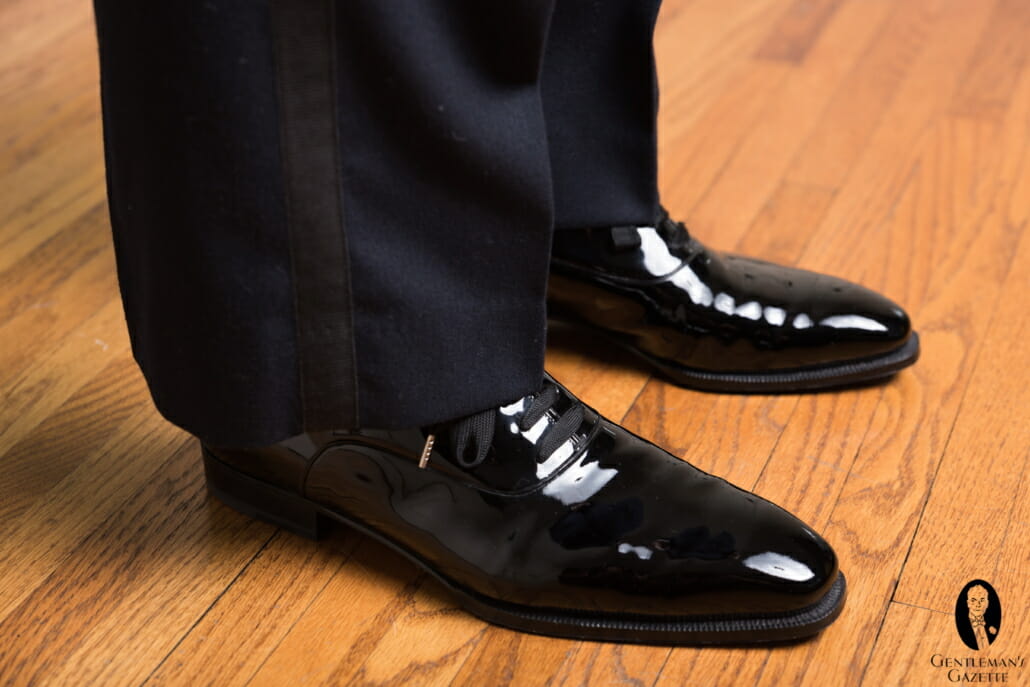
in regards to footwear, a low shoe laced or tied over the instep; one of two styles of acceptable formal shoes; compare with pump; see Classic Footwear page for different British and American use of the term (note: typically capitalized in British English)
Patent Leather
a leather with a hard, smooth, glossy finish on the surface; used for formal shoes
Peaked Lapel
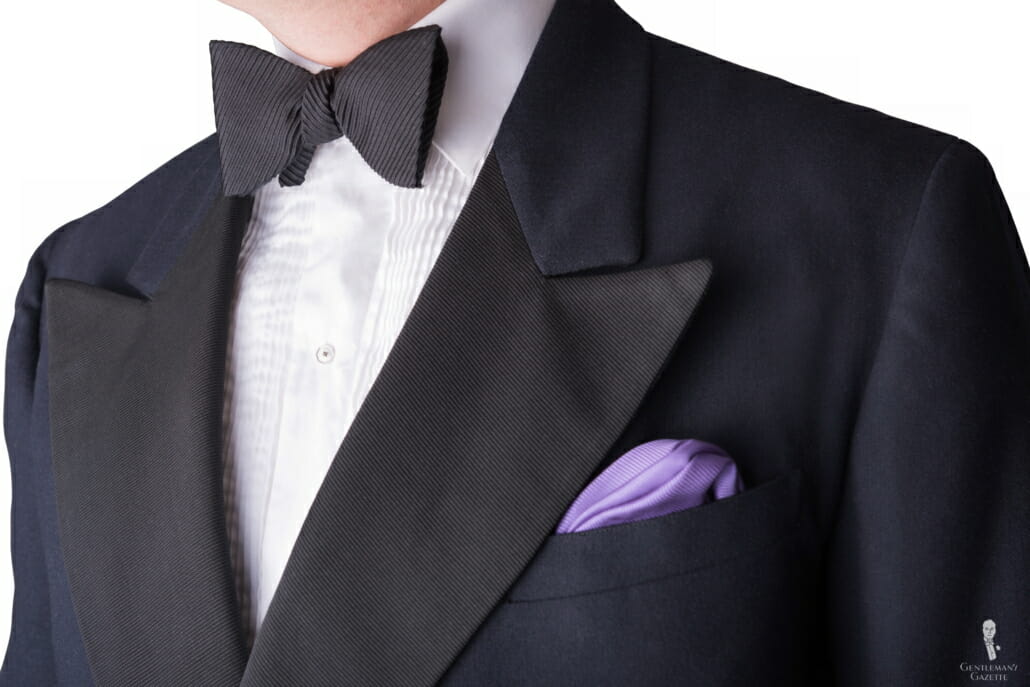
a style of lapel where the top line of the lapel slants upward from the collar seam; the most formal type of lapel; compare with notched lapel and shawl collar
Piqué

a tightly woven fabric with various raised patterns often found on formal shirts and full-dress waistcoats and bow ties; the finer the bead, the finer and more elegant the shirt; pronounced pee-KAY (see also marcella)
Placket
also “plaquet”; a separate strip of fabric sewn onto a shirt front to secure the buttonholes and provide structure and finish
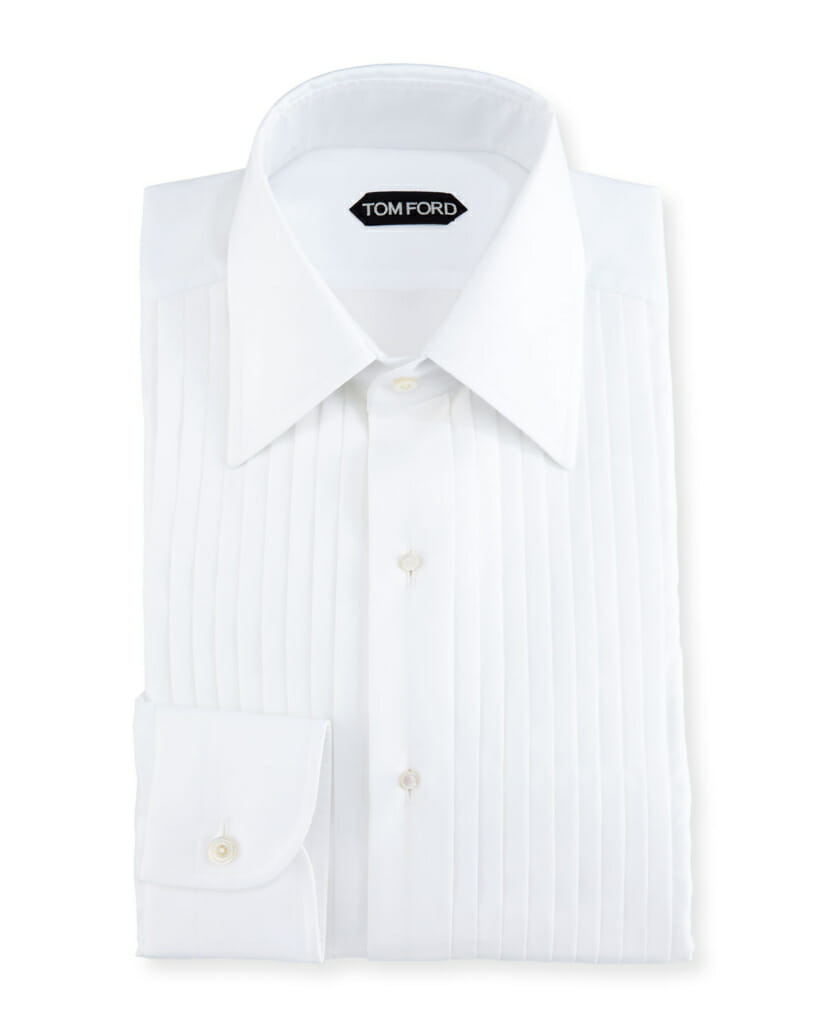
Pleat

(originally “plait”) a fold in cloth made by doubling material over on itself; used to decorate the bosom of black-tie shirts
Pocket Square
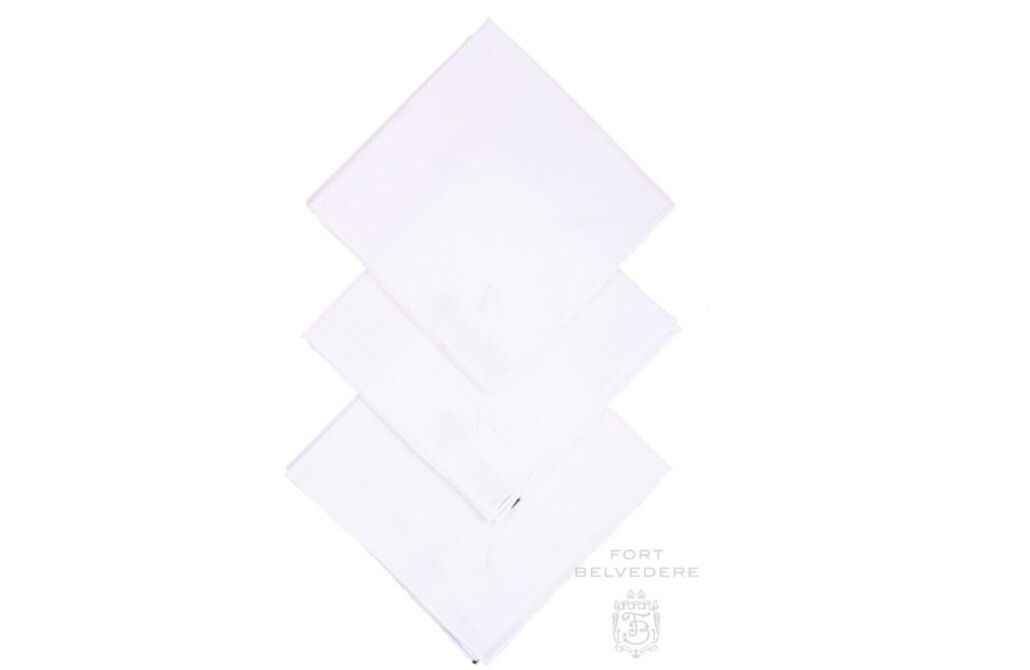
a silk or linen handkerchief folded decoratively and placed in the breast pocket of a coat
Poke Collar
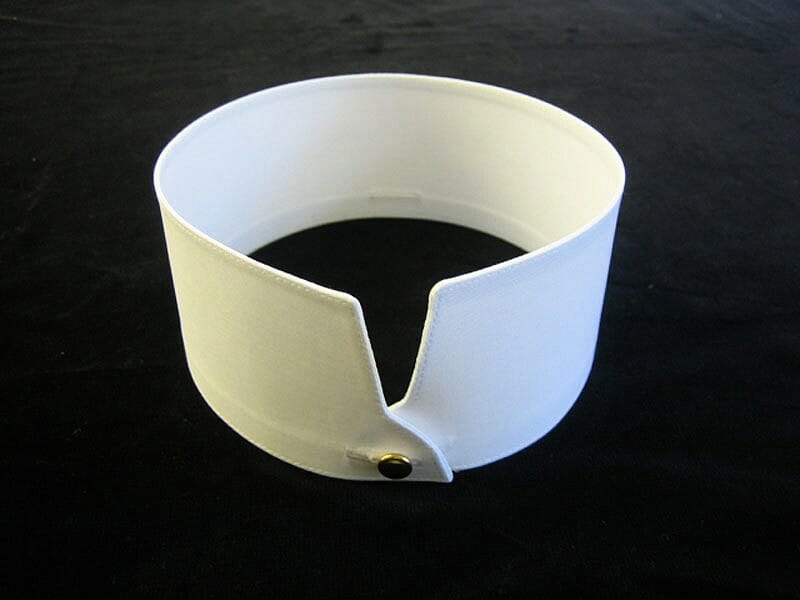
a standing detachable collar with a very slight curve of the corners in front; popular with formal shirts in the Victorian and Edwardian eras
Point Collar
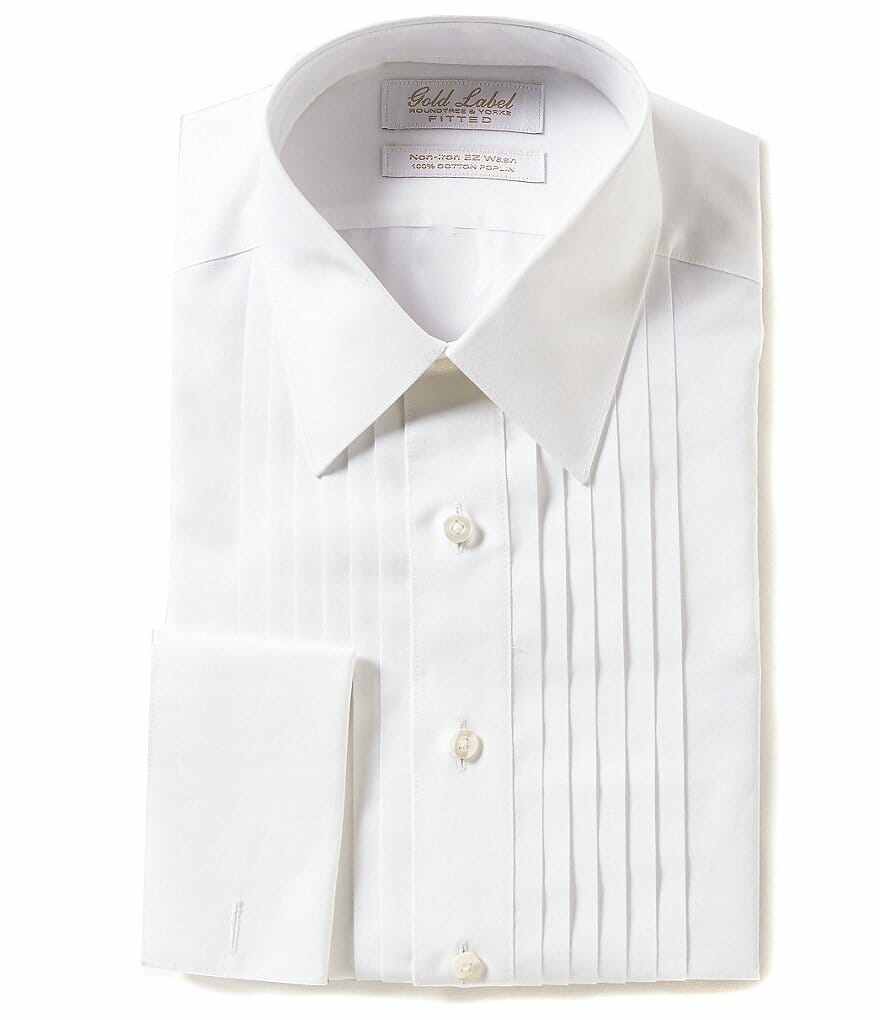
Pump
a low-cut, slip-on shoe that grips the foot chiefly at the toe and heel; formal evening pumps usually have an ornamental grosgrain bow in front and are made of patent leather or calfskin; also known as “opera pump” and “court pump”
Rever(s)

the reverse side of a lapel (or collar) exposed when a lapel is folded back
Ribbed Silk
Ruffle
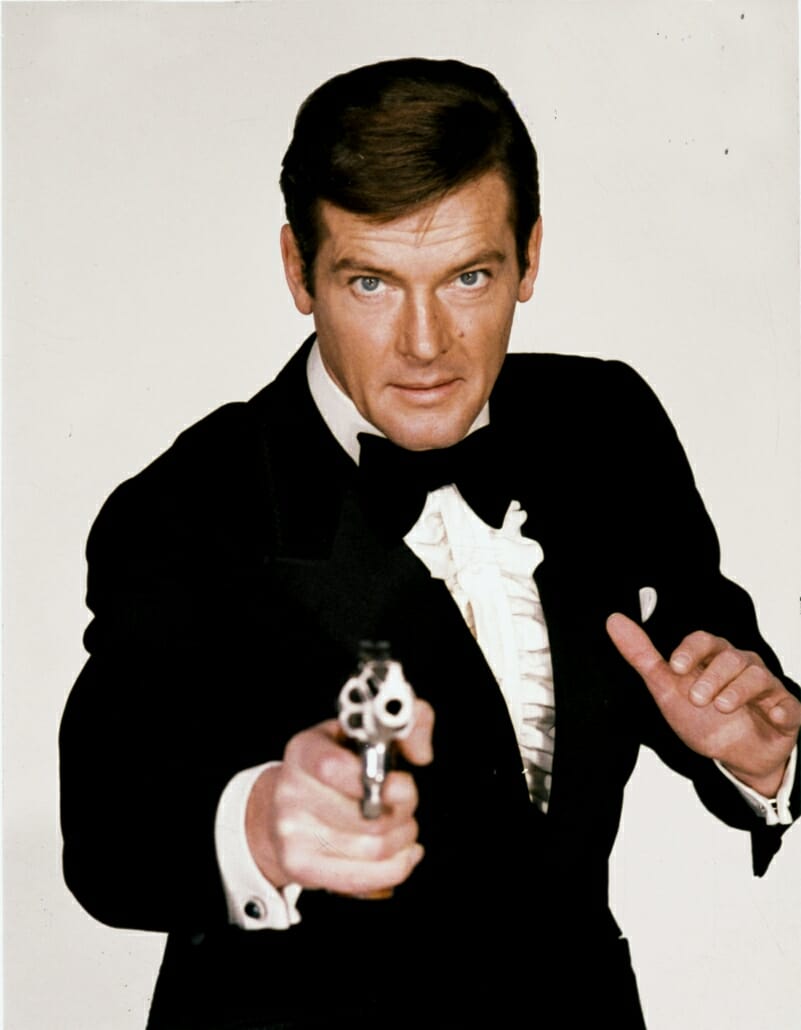
a strip of fabric gathered or pleated on one edge; popular on the bosom and sometimes cuffs of black-tie shirts in the late 1960s and’70s, often with embroidered edges in a contrasting color
Sack Suit
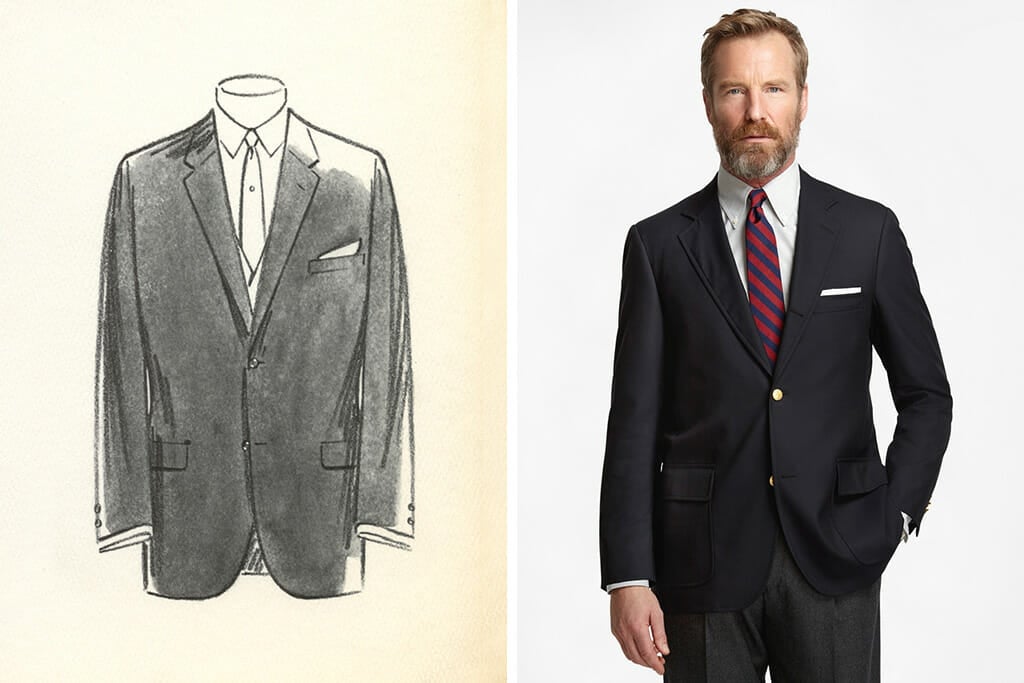
American term for early style of business suit; similar to British lounge suit
Satin
a fabric (as of silk) with lustrous face and dull back; used an an alternative to grosgrain in formal facings
Self-Faced
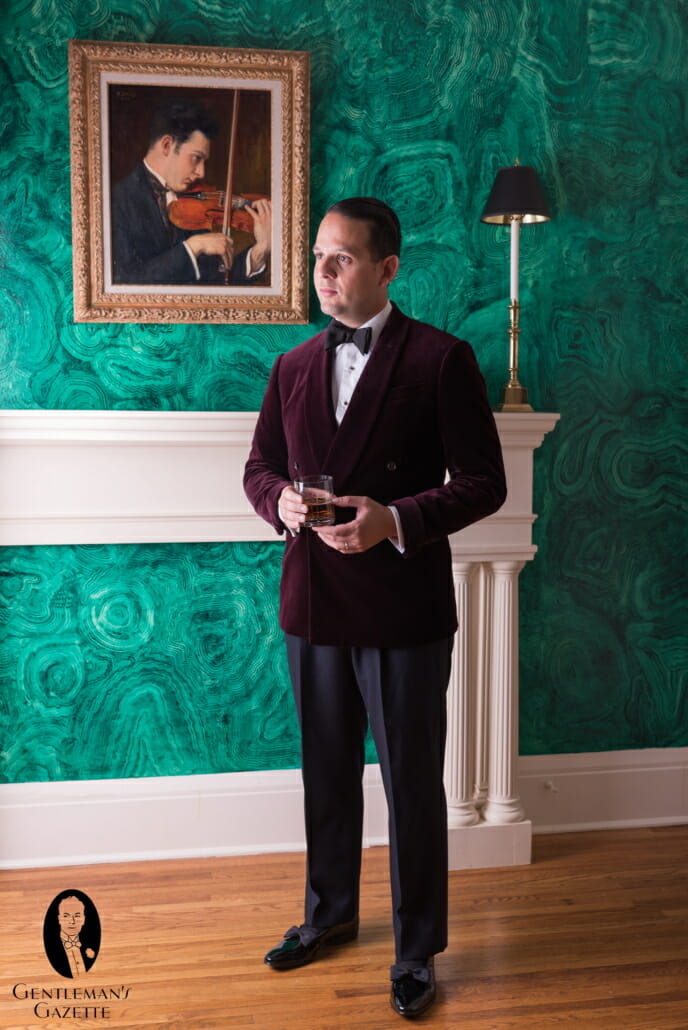
a facing made of the same fabric as the primary garment; standard for light colored dinner jackets or velvet dinner jackets
Self-Tie Bow Tie
a bow tie that requires tying by the wearer; contrast with “pre-tied” or “clip-on”
Semi-Formal
see Dress Codes
Sennit Hat
see “straw boater“
Shantung
a fabric in plain weave having a slightly irregular surface; popular in fashion forward black tie clothing in the late ’50s and ’60s
Shawl Collar
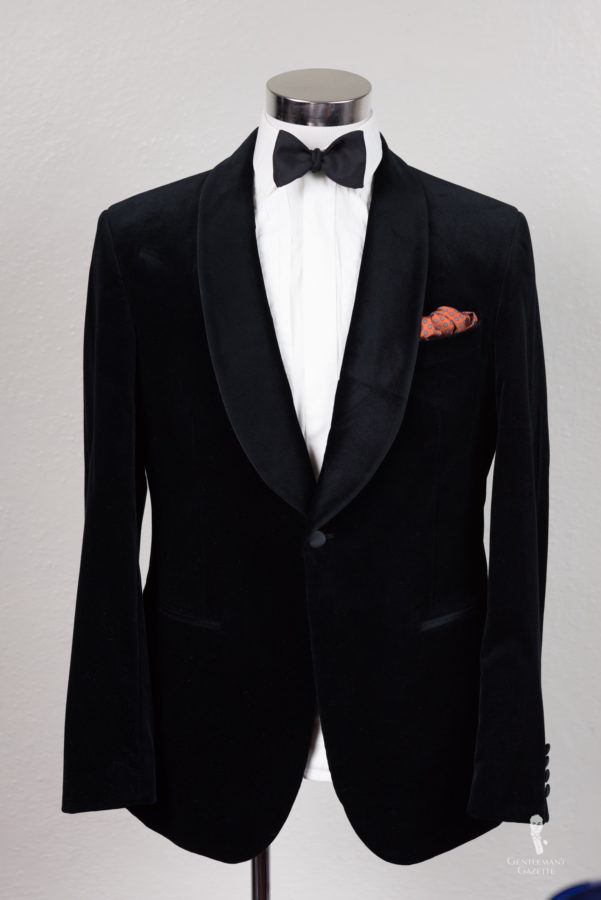
also “shawl lapel”; a turned-over collar of a garment that combines with lapels forming an unbroken curving line; compare with peaked lapel and notched lapel
Silk Hat
see “top hat“
Single-Breasted
having a center closing with one row of buttons and no lap; found in coats, overcoats and waistcoats; compare with double-breasted
Single Cuff
soft or starched shirt cuff of one thickness; found on stiff-front shirts it is fastened with cuff links; also known barrel cuff (esp. in US); compare with French cuff
Sized Bow Tie
a single-piece self-tie bow tie sized for a specific neck measurement. Advantageous especially for detachable collars as there is no adjuster, just one continuous band.
Skirt
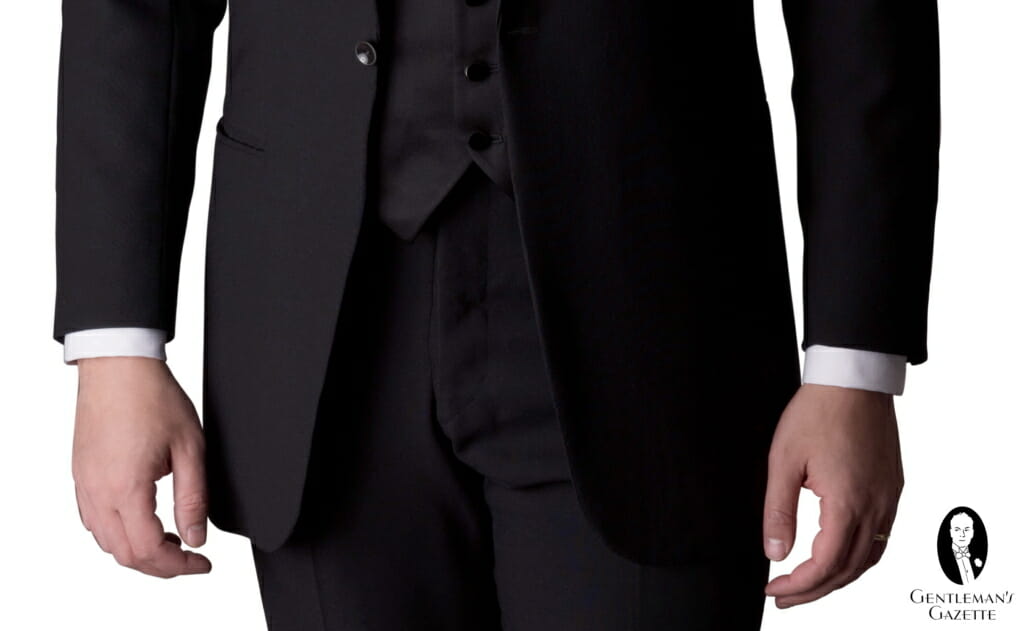
on a jacket or coat, the portion of the garment below the waistline
Slit Pocket
see “besom pocket“
Smoking Jacket

a garment designed for wear while smoking tobacco; traditionally made of velvet or sometimes silk, with a shawl collar, decorated cuffs and toggle fastenings; can be substituted for a dinner jacket in less formal settings; in continental Europe also used to describe a dinner jacket, see black tie terminology
Sock Garter
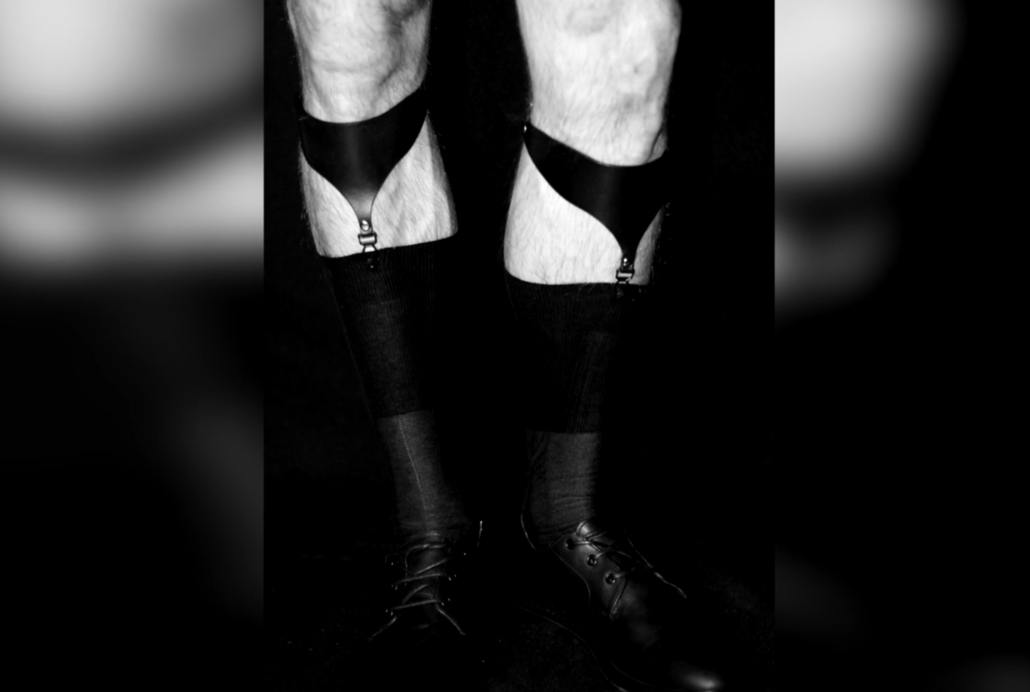
a band worn to hold up a stocking or sock; ensures that mid-calf formal socks will not bunch or slide; very uncomfortable and awkward to wear; instead get true over-the-calf silk socks for a proper black tie look
Spread Collar

a shirt collar with points spread apart enough to accommodate a large tie knot and end underneath the jacket collar; considered a dressier style than the pointed collar
Stiff-Front Shirt
a.k.a. “boiled shirt“; a collarless formal shirt with a bosom and cuffs formerly so rigid that the garment had to be boiled to remove the heavy starching in contrast to “semi-stiff” or “soft” shirts that use moderate or no starch; worn with a stiff detachable collar
Stud
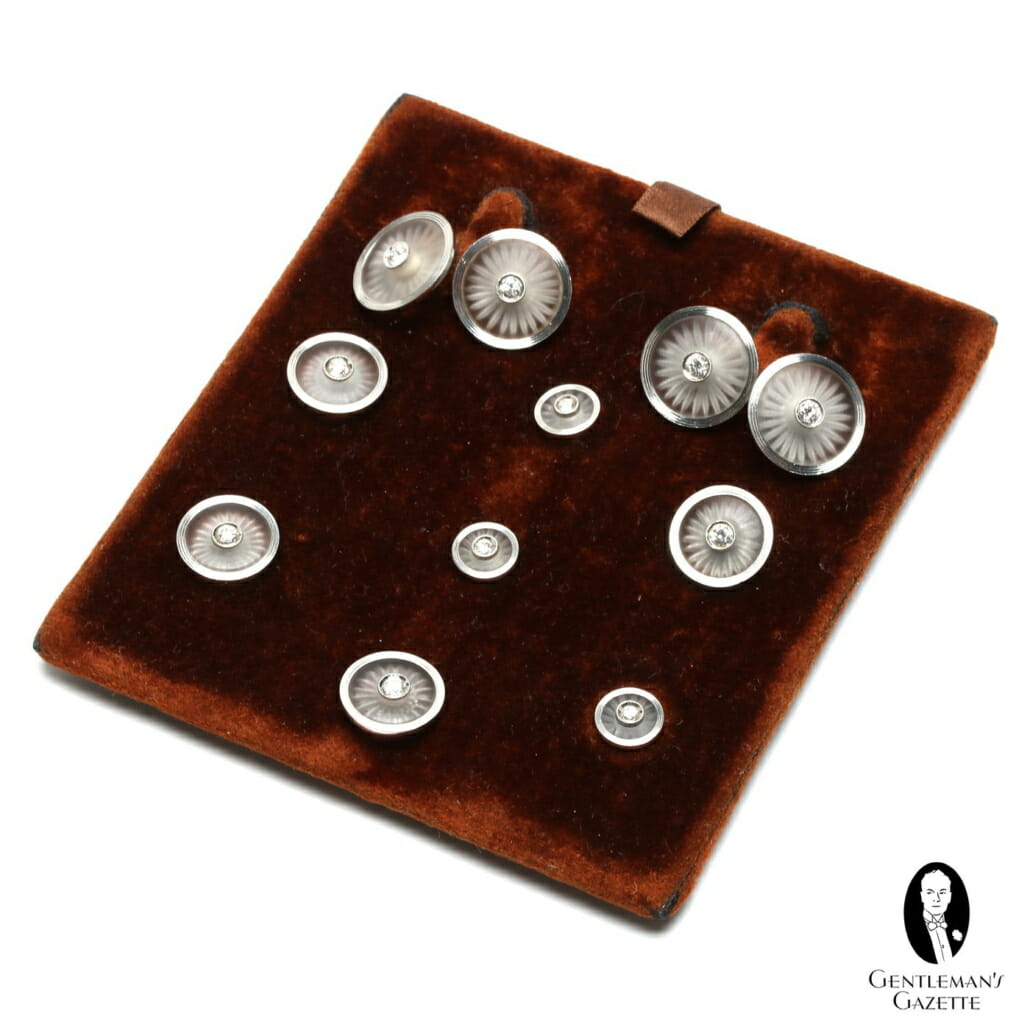
a solid button with a shank or eye on the back inserted through an eyelet in a formal shirt, formal waistcoat or detachable collar as a fastener or ornament
Straw Boater
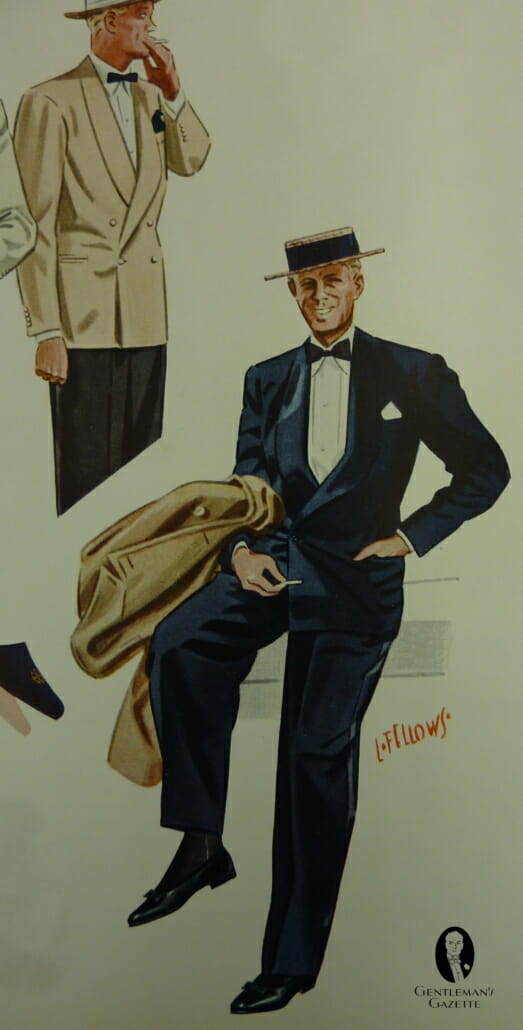
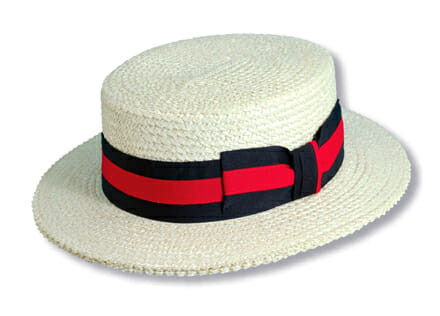
also known as a “Sennit straw hat”; popular summer headwear for black tie in the 1930s. Check out the Straw Boater Hat Guide for more information.
Swiss Pleat
see “tucks“
Tailcoat
a formal indoor coat defined by a long skirt that is cut away in front at the waist and divided by a long center vent in the back; typically a morning coat for formal day wear or an evening tailcoat
Tartan
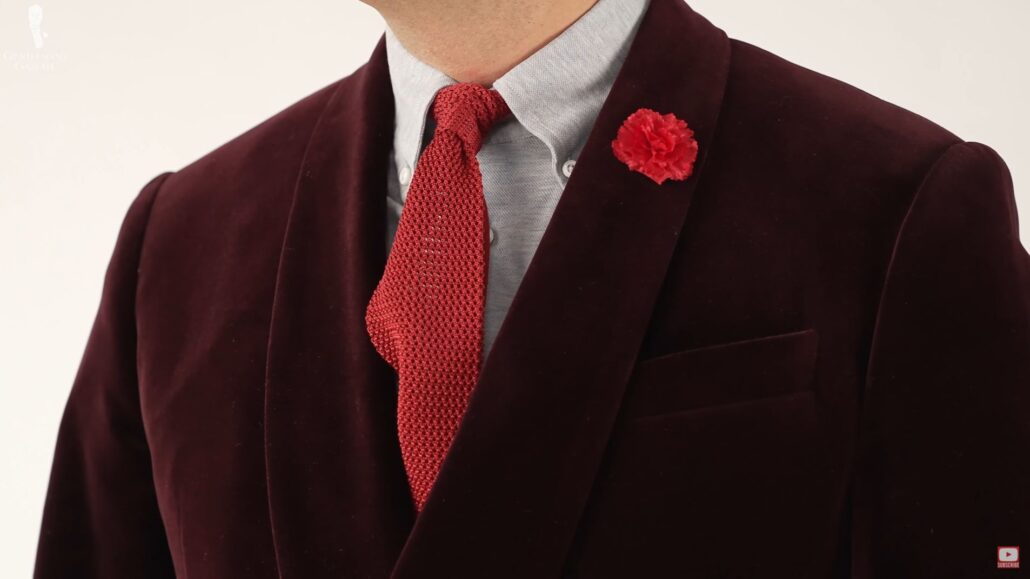
a plaid textile design of Scottish origin consisting of stripes of varying width and color usually patterned to designate a distinctive clan; the green and navy blue “Black Watch” pattern (pictured) has been the favored plaid for informal dinner jackets since the ’50s
Thistle Bow Tie
see “butterfly bow tie“
Top Hat
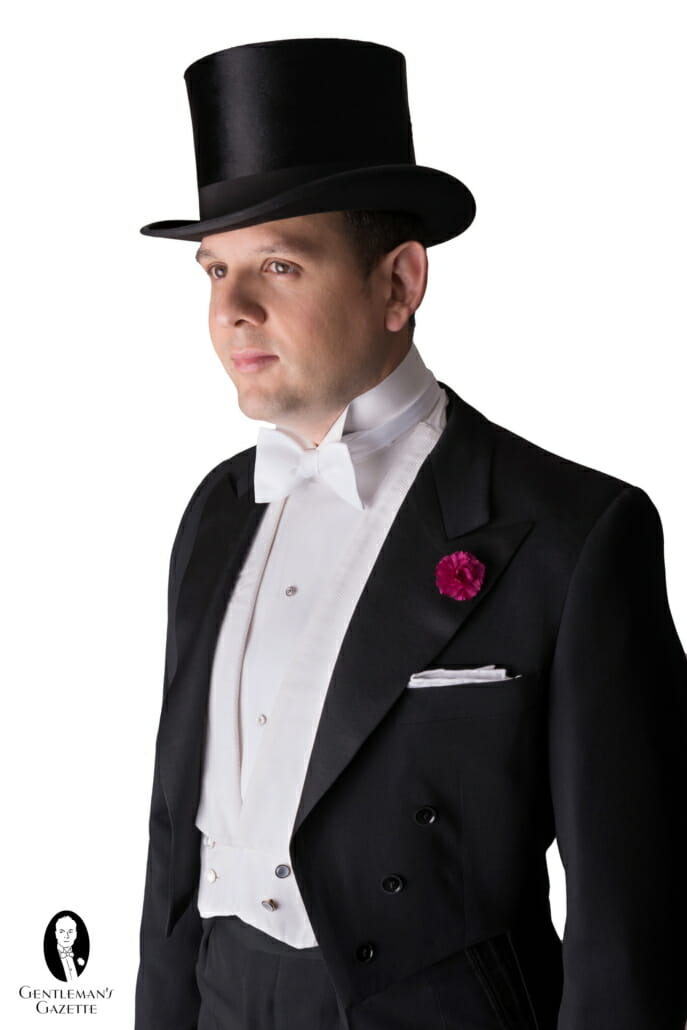
tall, stiff-crowned hat with rolled-edge brim; worn in black silk with white tie, also worn in gray felt with black band with morning dress; also known as “silk hat” and “topper”; see also opera hat
Tucks
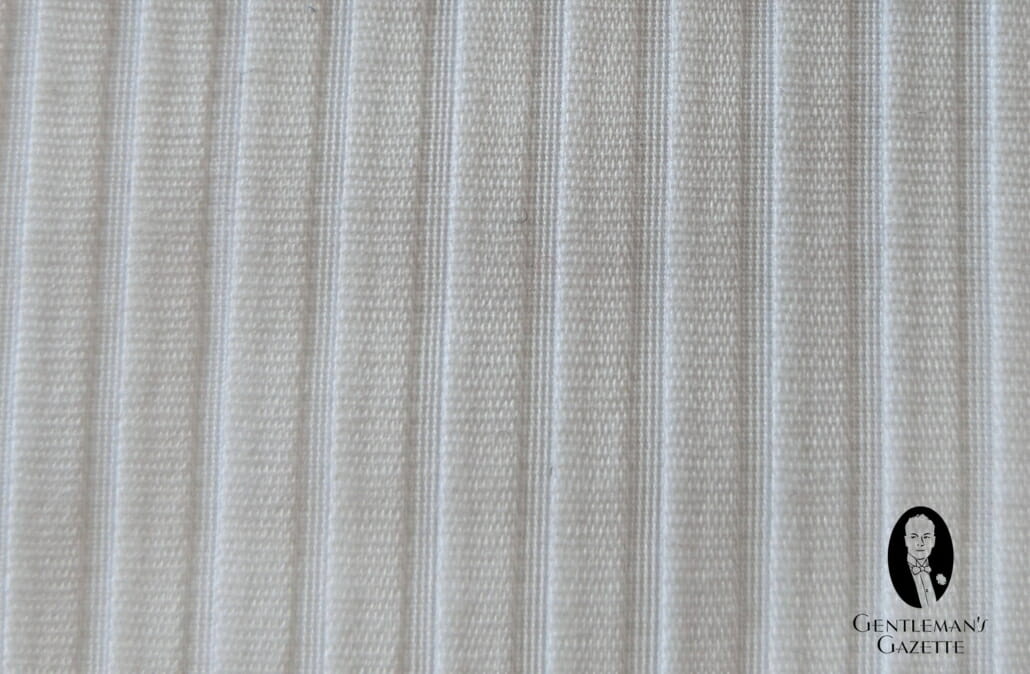
pleats that are sewn in place along the folded edge; “pin tucks” are very narrow tucks; also known as swiss pleats; sometimes used to decorate black-tie shirt bosoms
Turndown Collar
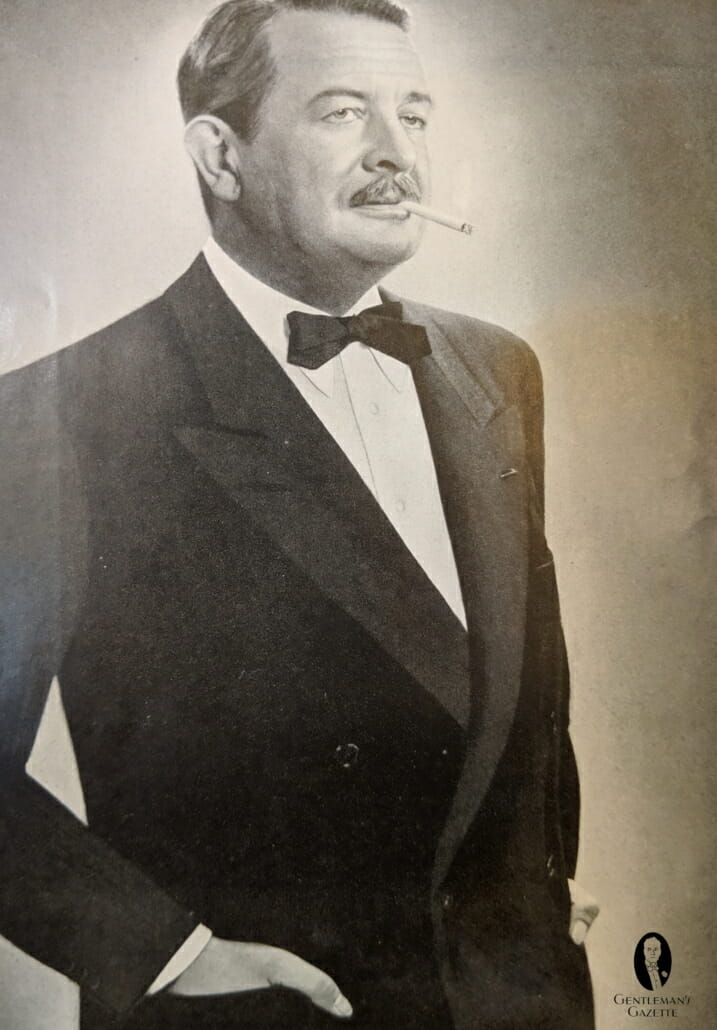
a standard shirt collar folded back on itself with cutaway front ends to allow for a tie knot; also known as a “fold collar”; depending on the spacing between the collar points it can be designated either a spread collar or a pointed collar
Tuxedo
see Comparative Black Tie Terminology
Vamp

the front part of the upper portion of a shoe that covers the toes and part of the foot; a slip-on (pictured) and an oxford have long vamps while a pump has a a very short one
Velvet
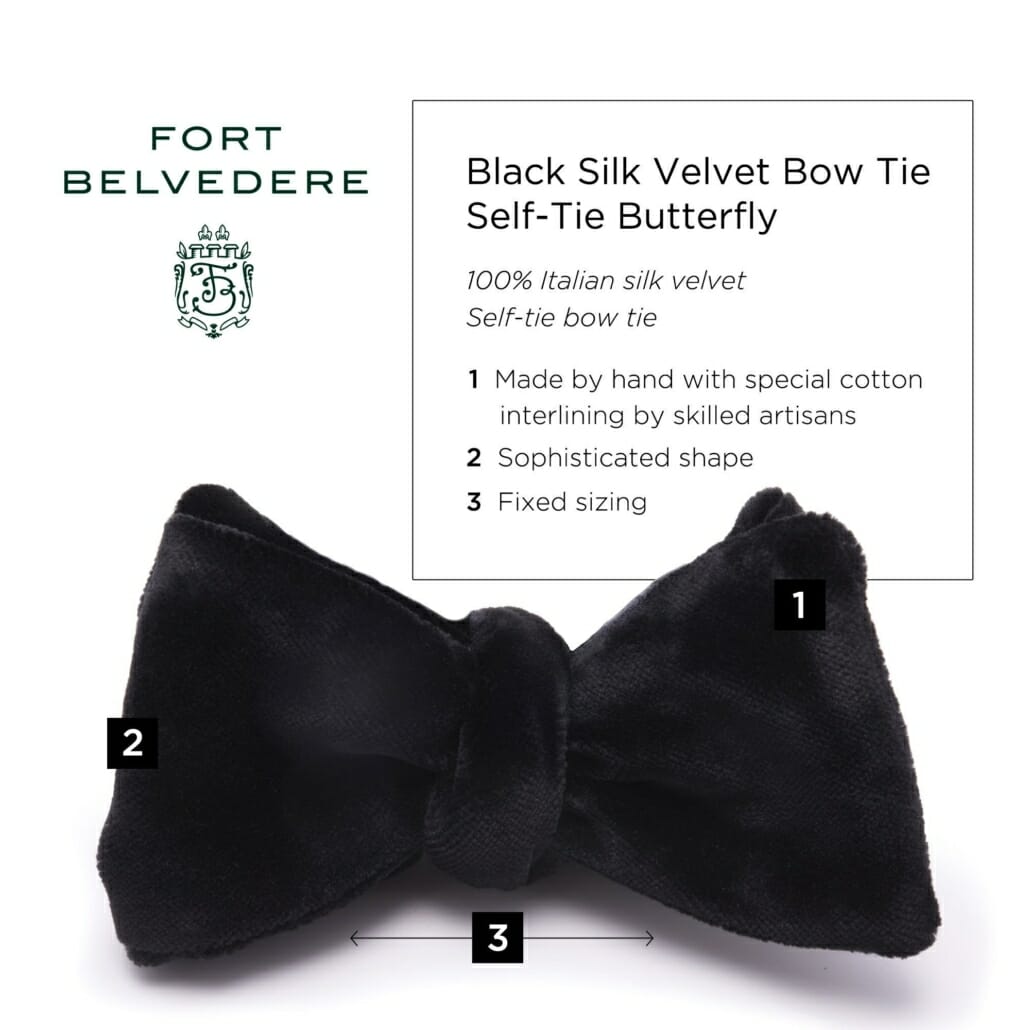
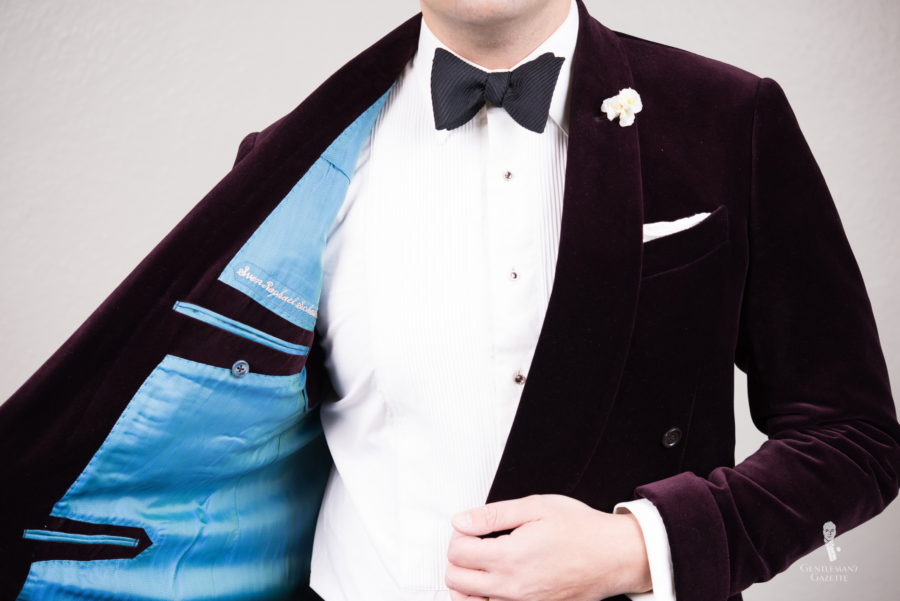
a clothing and upholstery fabric (as of silk, rayon, or wool) characterized by a short soft dense warp pile; used as an alternative to worsted wool in dinner jackets and as an alternative formal facing especially in the ’60s and ’70s
Vent
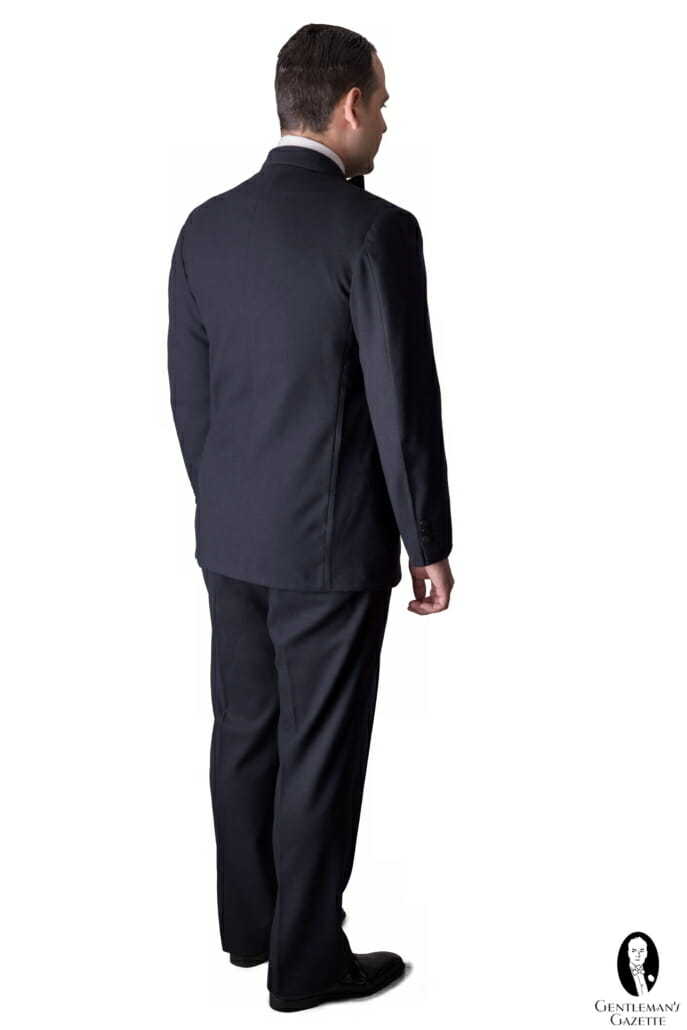
an opening in the lower part of a garment seam (as of a jacket or skirt); dinner jackets are most formal when they are not vented but two “side vents” can be a practical and acceptable alternative; a (rear) “center vent” is not appropriate for formal wear
Vest
see “waistcoat“
Vicuna
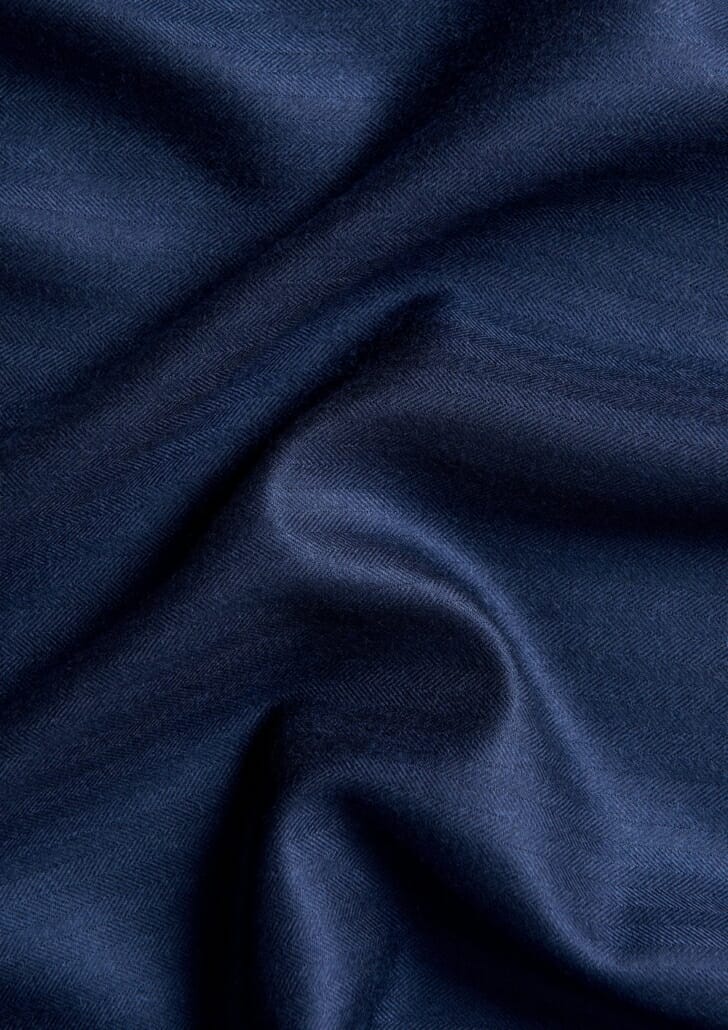
an extremely soft and expensive wool from the fine lustrous undercoat of the vicuña, a South American relative of the llama and alpaca
Voile
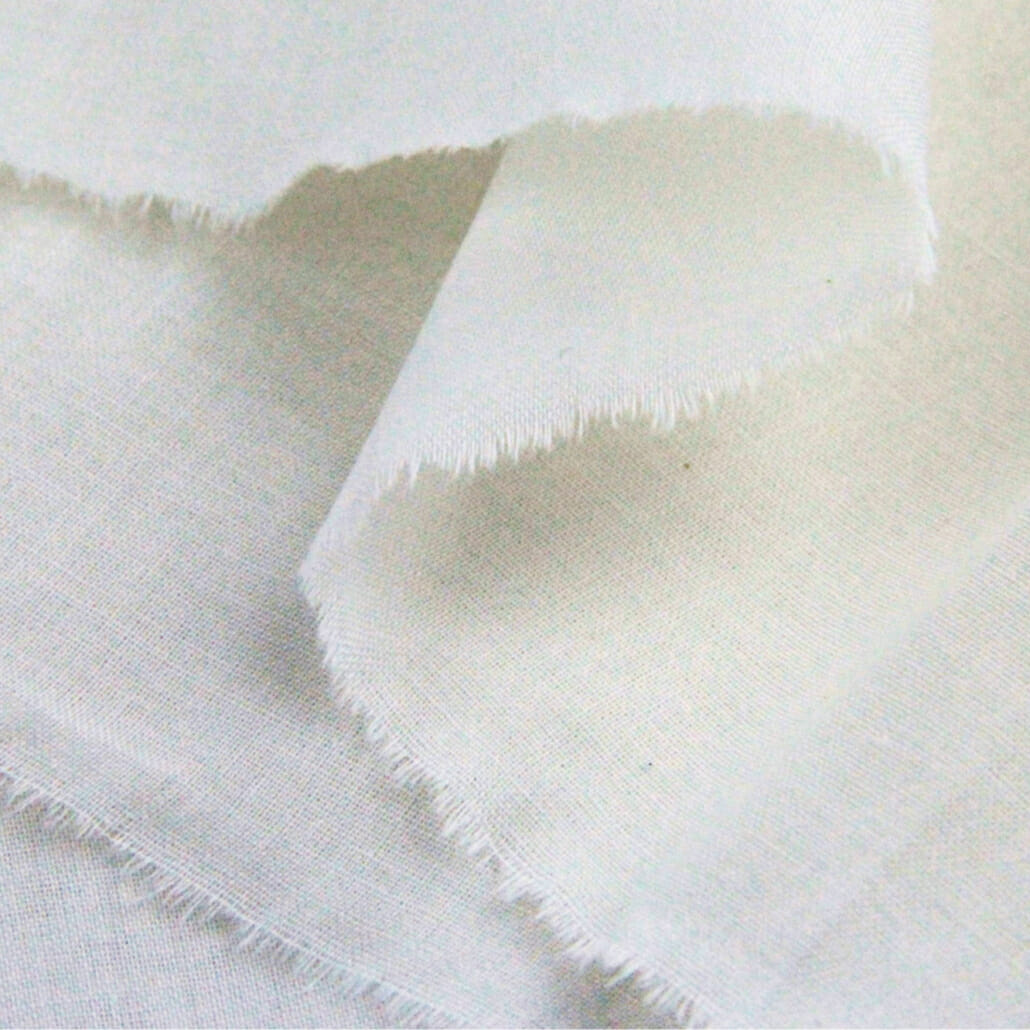
a fine, lightweight fabric; because of its sheerness voile dress shirts are made with double-layer bosoms and worn primarily for warm weather; pronounced “voil”
Waist Covering
see “waistcoat” and “cummerbund“
Waist Suppression
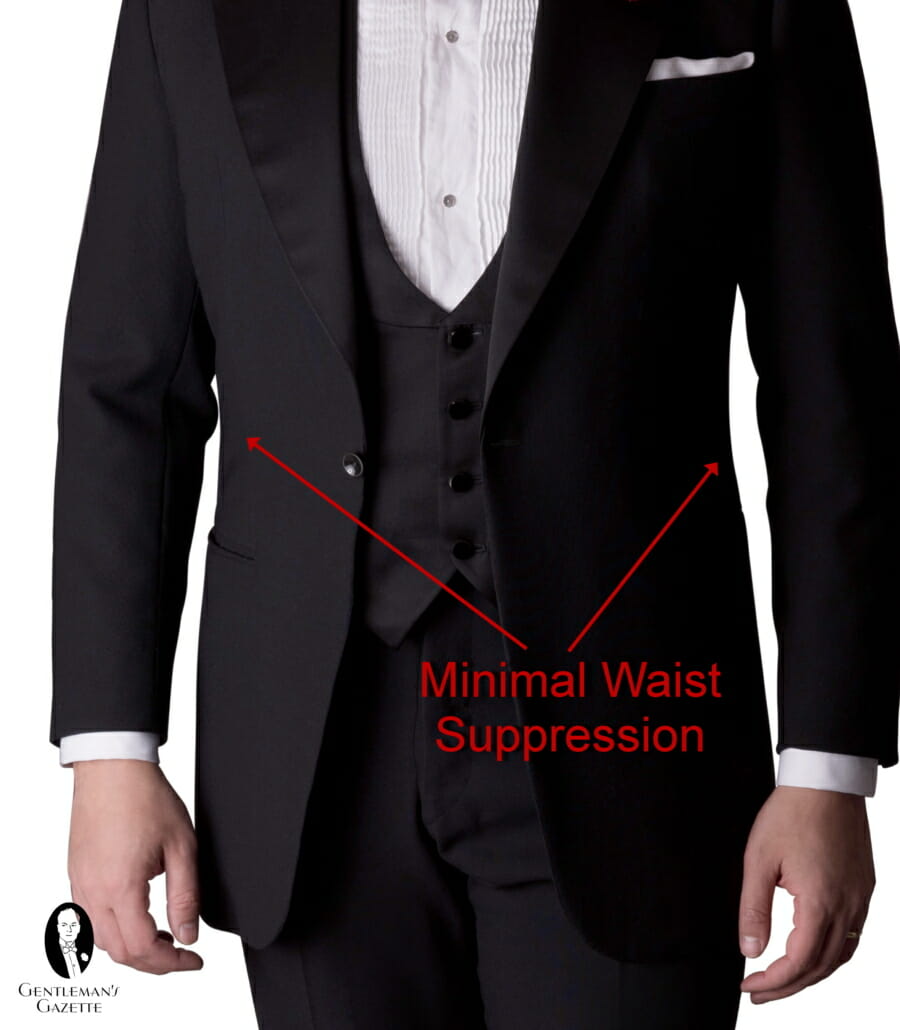
the addition of shape at the waistline of a garment; usually very moderate in dinner jackets
Waistcoat
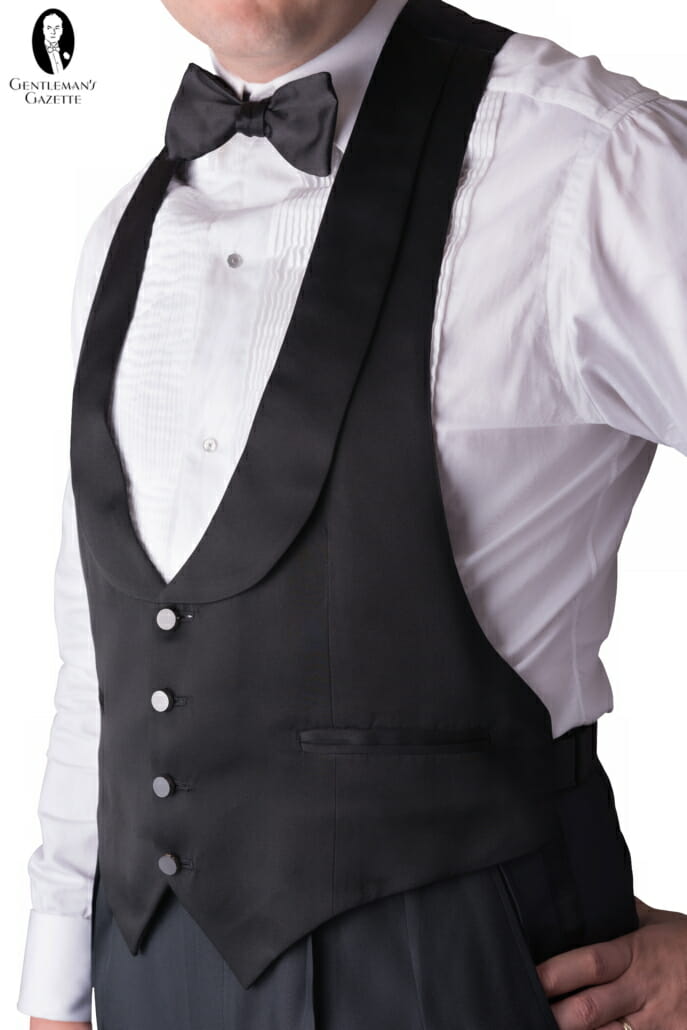
also known as “vest” in North America; a sleeveless garment for the upper body usually worn over a shirt; evening waistcoats are traditionally low cut and lapelled as shown; can be “backless” or have a “full back” or have a “half back”
Welt Pocket
an inset pocket with the lower lip finished by an upstanding welt (extra strip of fabric or stitching that is sewn or otherwise fastened to a pocket to strengthen or adorn it); typically used for breast pockets on suit jackets
White Tie
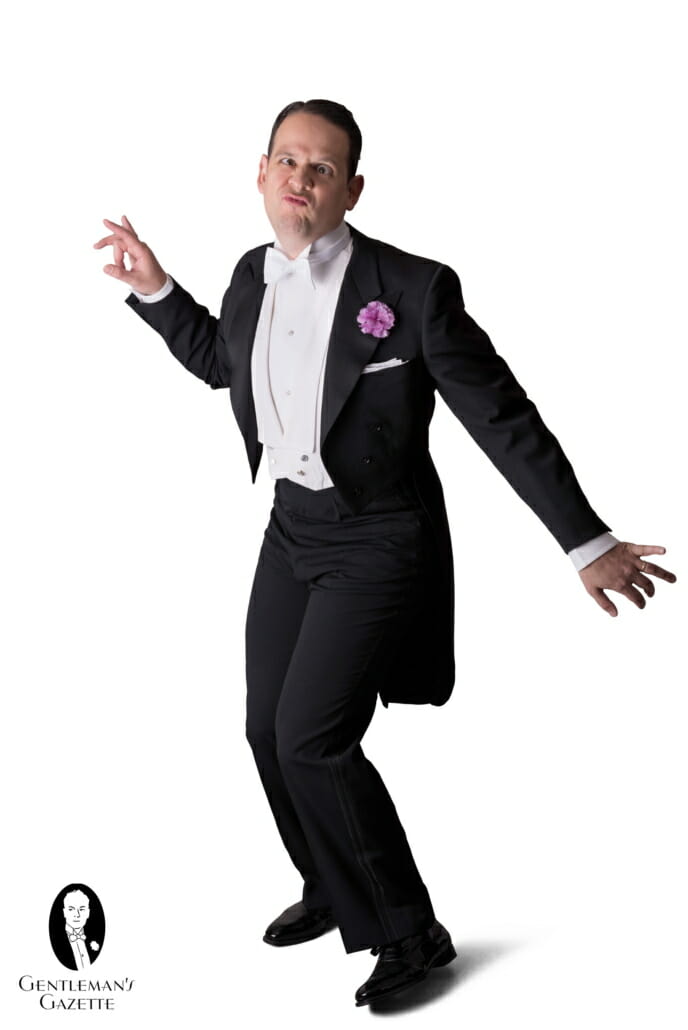
the most formal type of civilian dress code consisting of specifically defined attire (note: written as “white-tie” when used as an adjective)
Wing Collar
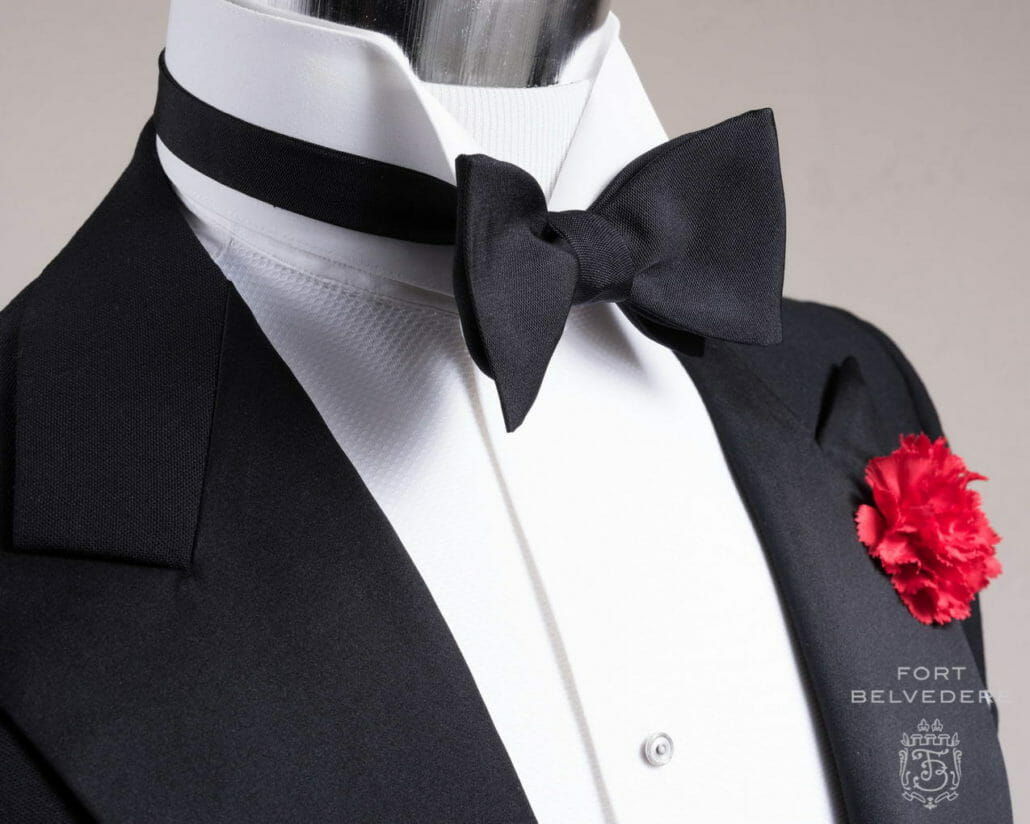
a standup shirt collar with the front tips folded over to form tabs called “wings”; not to be confused with “wing tips” which is a shoe toe decoration; traditionally detachable but usually attached today
Worsted

a firm, napless (free of fibrous texture) fabric made with a smooth, compact yarn from long wool fibers; can be “finished” (treating the surface of the fabric to improve its appearance) or “unfinished”
Explore this chapter: 9 Advanced Black Tie & Tux Coverage
- 9.1 Black Tie, Tuxedo & White Tie Evening Wear Glossary
- 9.2 Black Tie Dress Code for Women – Ladies’ Evening Wear
- 9.3 Tuxedo Black Tie Myths & Merits Debunked
- 9.4 Orders Decorations & Medals with Black Tie & White Tie
- 9.5 Clerical Formal Wear
- 9.6 Military Formal Attire – Mess Dress
- 9.7 Scottish Highland Dress, Irish, and Welsh Formal Black Tie & White Tie Attire
- 9.8 Women’s Tuxedos and Tailcoats
- 9.9 Smoking Jacket Guide
- 9.10 Formal Evening Wedding Attire & Etiquette
- 9.11 How To Wear A Tuxedo Like James Bond


